|
Chevrolet Anderson, IN
1945 Open House
Chevrolet World War Two Truck
Database
Chevrolet Division of General Motors in World War Two
Flint, MI
1911-Current
This
page updated 1-11-2023.
It is
somewhat of a challenge to fully represent Chevrolet's contribution to the
American Defense during World War Two. In spite of being the
largest of GM's car divisions, information and production statistics are
meager, if not non existent. Chevrolet did not do a very good job
of documenting wartime production numbers and plant locations for historical purposes. What is provided below is the best I have
been able to obtain with the limited information available.
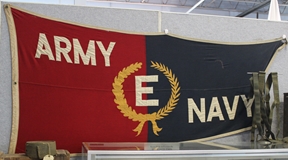
The Chevrolet Aviation
Plant No.2 in Tonawanda, NY won the Army-Navy "E" Award five times.
The Chevrolet Aviation Plant No.1 in Buffalo, NY won the Army-Navy "E" Award five times.
The Chevrolet Motor and Axle Plant in Tonawanda, NY won the Army-Navy
"E" Award five times.
The Chevrolet Motor Plant in Bay City, MI won the Army-Navy "E" Award two times.
The Chevrolet Motor Commercial Body Plant in Indianapolis, IN won the
Army-Navy "E" Award three times.
The Chevrolet Gear and Axle Plant in Detroit, MI won the Army-Navy "E" Award four times.
Chevrolet
World War Two Production Statistics: 439,893 Chevrolet and GMC trucks (See below
for the details.), 2,583 Passenger Sedans, 3,844 Staghound Medium
Armored Cars,
60,766 R-2800 and R-1830
Pratt & Whitney Radial Aircraft Engines (17 Chevrolet Plants involved
with final assembly at Tonawanda, NY., 75mm armor piercing and high
explosive projectiles, 3 Inch armor piercing and high explosive
projectiles, 2,000 90mm Anti-aircraft gun tubes, breech ring and
block, and recoil rails, 200 million pounds of aluminum forgings
included forged aircraft propeller blades from four plants, making it
the second largest producer of aluminum forgings in the world, 5.7 million pounds
of magnesium castings, and two billion pounds of grey iron castings and
aluminum castings.
Trucks:
A total of 281,570 Chevrolet
name plated trucks consisting of:
55,579 1/2 ton 4x2 trucks
128 3/4 ton 4x2 trucks
52,568 1-1/2 4x2 trucks
173,295 1-1/2 4x4 trucks
(See my Chevrolet WWII
Truck Database for more details.)
158,323 Chevrolet-built GMC branded
trucks consisting of:
151,575 CCKW 6x6 2-1/2 ton trucks.
This was 30% of all CCKWs built. 149,135 were built at
the Chevrolet St. Louis, MO plant and 2,650 in the Baltimore, MD
assembly plant. At the end of the war, all CCKW production had
shifted to St. Louis. In 1944 and 1945, the daily run rate for CCKWs
was larger at St. Louis than at the GMC plant in Pontiac, MI.
Therefore, while all of the nameplates on the CCKWs are GMC, if the
truck was built in 1944 or 1945, there is a greater than 50% chance that
it is the Chevrolet-built version. All CCKWs built in St. Louis, with
the exception of the last 1,000 units, had Chevrolet axles on them.
Chevrolet built both the CCKW-352 and 353; the
former being the 145 inch short wheelbase version with a nine foot bed,
and the latter being the 164 inch long wheelbase type with a twelve foot
bed. Both types came with or without a front mounted winch.
6,748 of the GMC-designed 6x6 Amphibious
Trucks (DUKW) were assembled by Chevrolet in its St. Louis, MO plant.
This was 32% of the total of 21,147 built. GMC supplied the
sheet metal "boat" section pre-assembled from its plant in Pontiac, MI.
GMC sub-contracted the work to Chevrolet and all DUKWs built carried a GMC ID tag, even though the final assembly was carried out by
Chevrolet. Therefore, it is impossible to determine whether a DUKW
was built by GMC or Chevrolet, just as with the CCKW.
Chevrolet components on GMC Trucks:
Chevrolet supplied the original closed passenger cabs, the open
soft top cabs, many of the axles which were similar to the ones used
on its 1-1/2 ton truck, and the engine cowlings for not only the CCKW,
but other GMC 2-1/2 trucks. St. Louis also helped build 37,803
cargo dump trucks, of which the last forty units built were
cargo dump trucks. Chevrolet also built 3,330 cabs and chassis
only for F3 750 gallon fuel tankers and L1 660 gallon lubricant tankers
for the Army Air Corps.
For Britain: 3,844 Staghound Medium
Armored Cars of which 2,844 were T17E1 with 37mm cannon and
1,000 were T17E2 with twin .50 machine gun anti-aircraft units.
During World War Two Chevrolet built the 1-1/2
ton trucks in ten assembly plants. Each one had a code which was the
first number in the serial number.
|
Chevrolet Vehicle Assembly
Plants |
|
Plant Number |
Location |
|
1 |
Flint, M |
| 2 |
Tarrytown, NY |
| 3 |
St.
Louis, MO |
| 5 |
Kansas City, KS |
| 6 |
Oakland, CA |
| 8 |
Atlanta, GA |
| 9 |
Norwood, OH |
|
14 |
Baltimore,
MD |
|
20 |
Van Nuys, CA |
|
21 |
Janesville, WI |
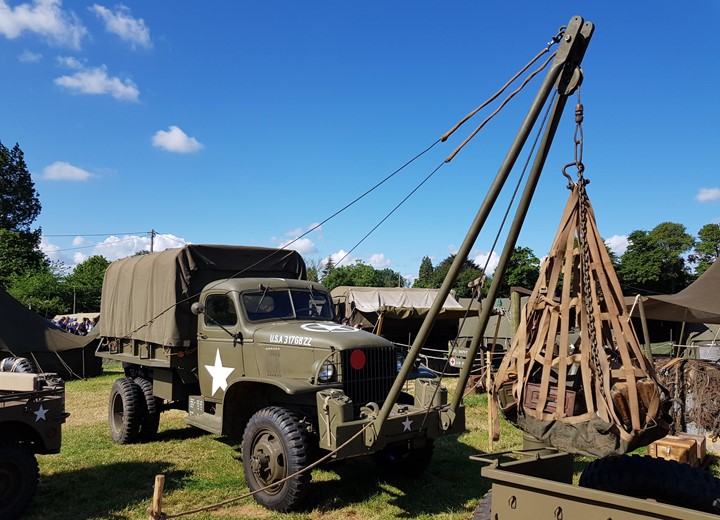
This Chevrolet truck was photographed at the
75th Anniversary of D-Day in Normandy, France. Photo courtesy of
Pierre-Olivier Buan.
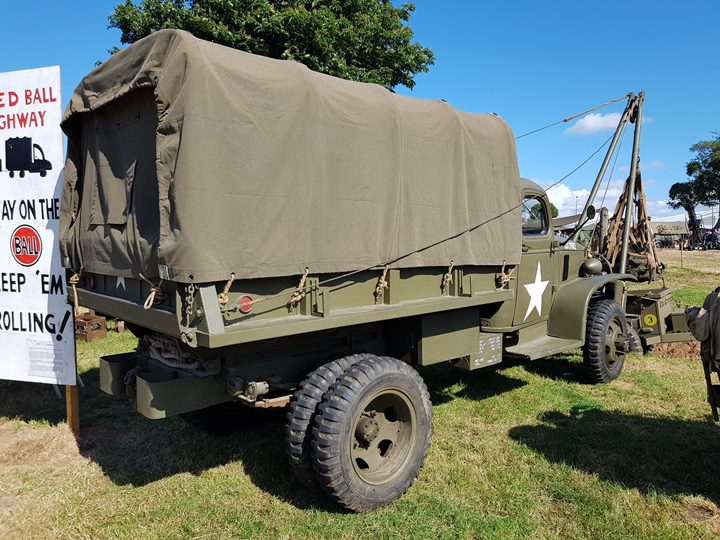
Photo courtesy of Pierre-Olivier Buan.
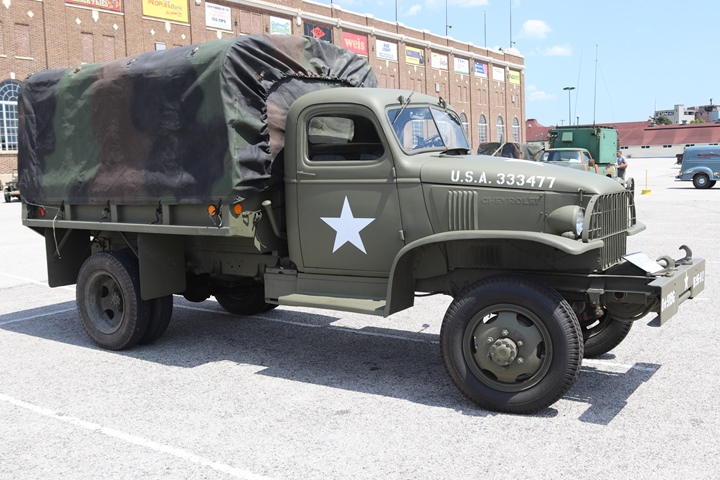
This Chevrolet cargo truck was on display at
the 2019 MVPA Convention in York, PA. Author's photo added
11-20-2020.
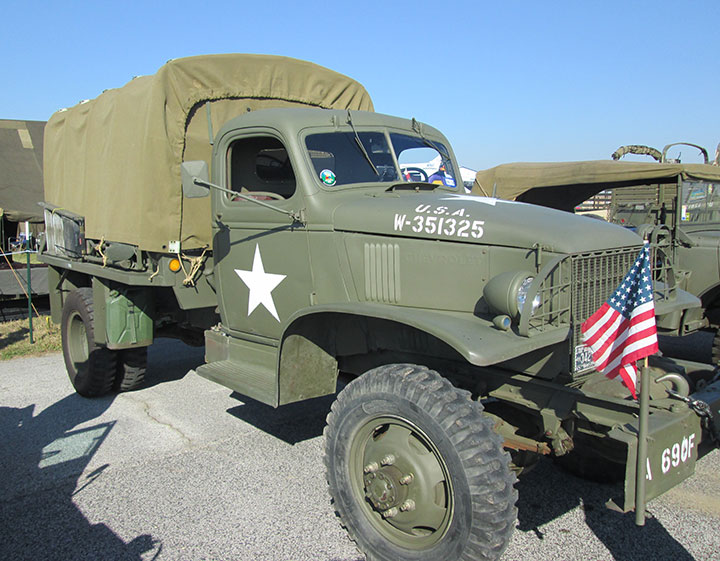
This is a photo of a 1941 Chevrolet 4x4 1-1/2 ton cargo truck with a winch, as seen at the
2013 Houston Airshow. Author's photo.
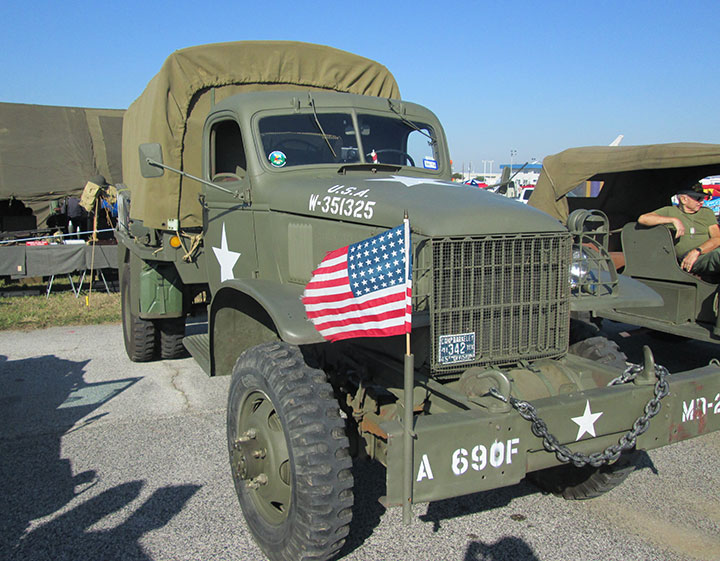
It can be determined from the tables on the
Chevrolet WWII vehicle
production page that this is a type ZM truck and
that 6,770 were built in 1941. Author's photo.
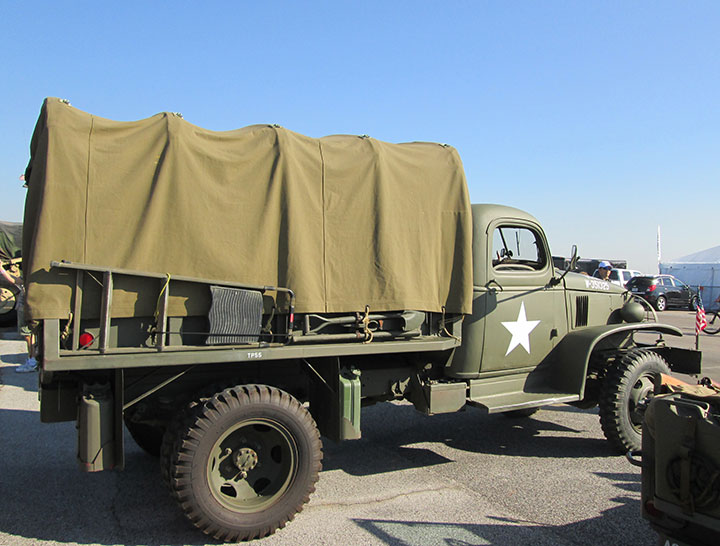
Author's photo.
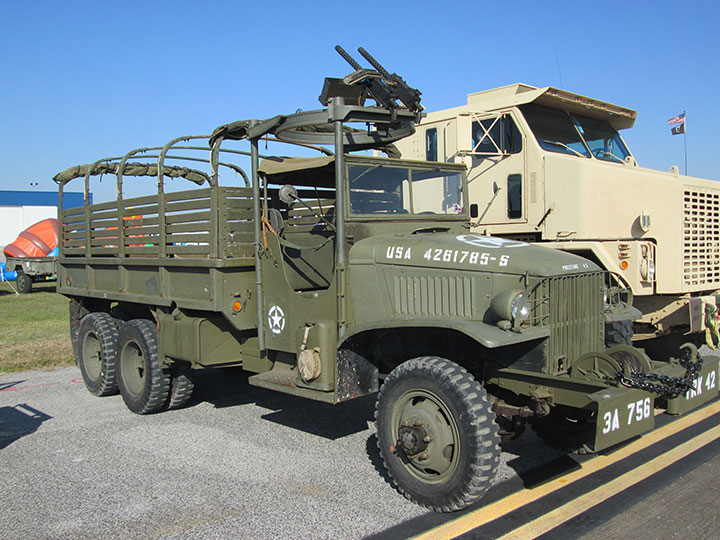
This 1943 GMC CCKW-353 2-1/2 ton truck with
winch was in the same display at Houston. It may very well
have come off the Chevrolet St. Louis production line. During 1943
GMC built 78,432 CCKWs and Chevrolet built 51,715. Note the similarity
in the engine cowling and grill with the previous Chevrolet truck.
They look very similar, as they came off of the same Chevrolet presses in
Flint, MI. Chevrolet also supplied many of the axles for the GMC,
which were similar to those on its own 1-1/2 ton series.
In 1943 Chevrolet St. Louis started building the open cab versions of the CCKW like this.
Prior to that time, it was building
the closed cab, like the one below. Author's photo added
12-24-2014.
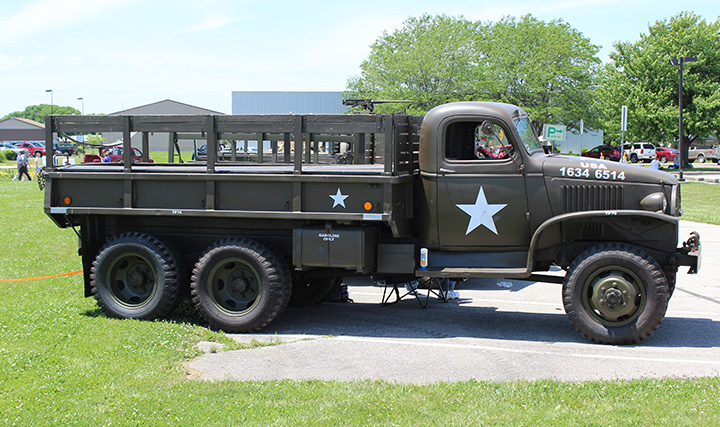
The original CCKWs came with the closed cab,
which the Chevrolet Division supplied for all of the CCKWs built by both
itself and GMC in Pontiac, MI. Chevrolet produced 40,070 of the
closed cab type CCKWs, like this CCKW-353 with no winch, seen at the 2014
Columbus, IN Airport Appreciation Day. Author's photo added
12-24-2014.
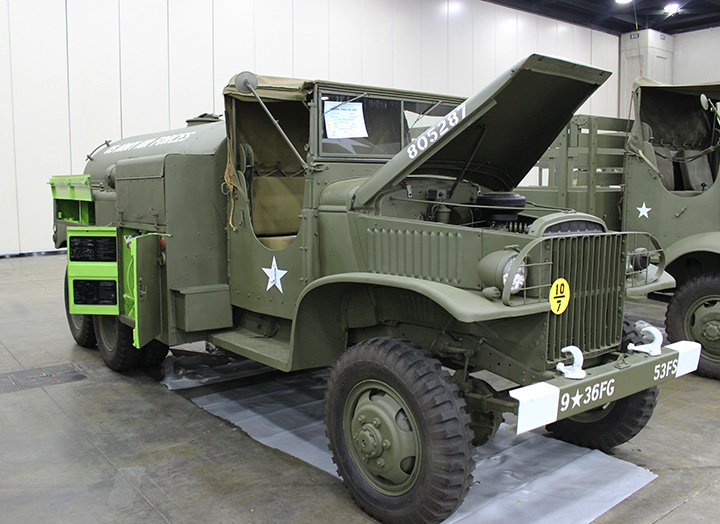
This 1944 F-3 Army Air Corps 750 gallon Aviation Fuel
servicing truck built on a CCKW-353 chassis and cab was at the 2014 MPVA
National Convention. Chevrolet St.
Louis provided all of the 3,330 cabs and chassis for these type
vehicles. Author's photo added 12-24-2014.
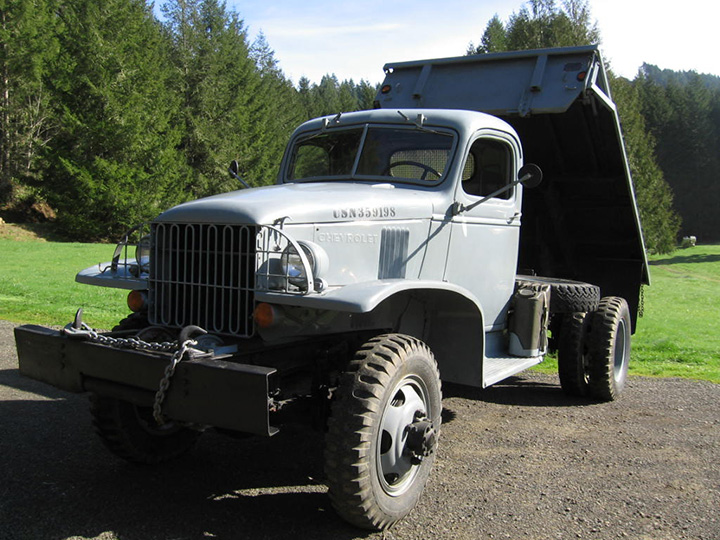
Over 70 years after being built in 1942,
this Chevrolet 1-1/2 ton dump truck is still used occasionally for odd
jobs by owner
Rob Ellert. Note that this model has the front winch.
Photo courtesy of Rob Ellert. Photo added 2-14-2015.
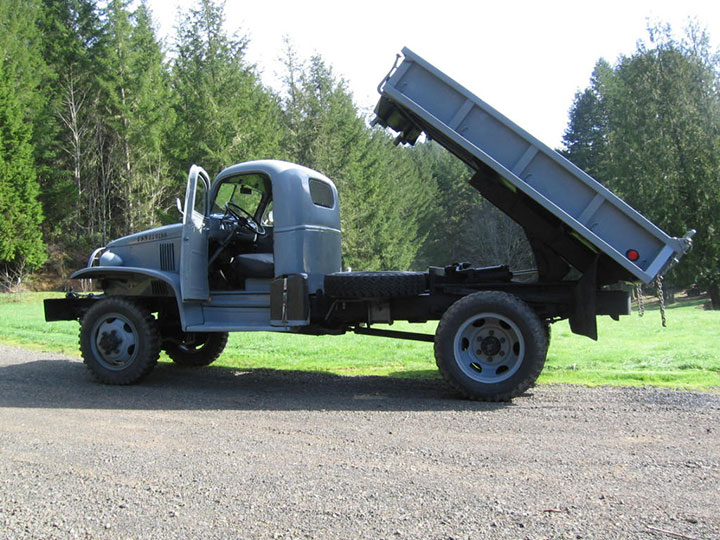
This nice looking example of the NL series
dump truck was one of 5,098 built by Chevrolet in 1942 for the military. After being built for the Army, it eventually was obtained
by the Navy. Photo courtesy of Rob Ellert. Photo added
2-14-2015.
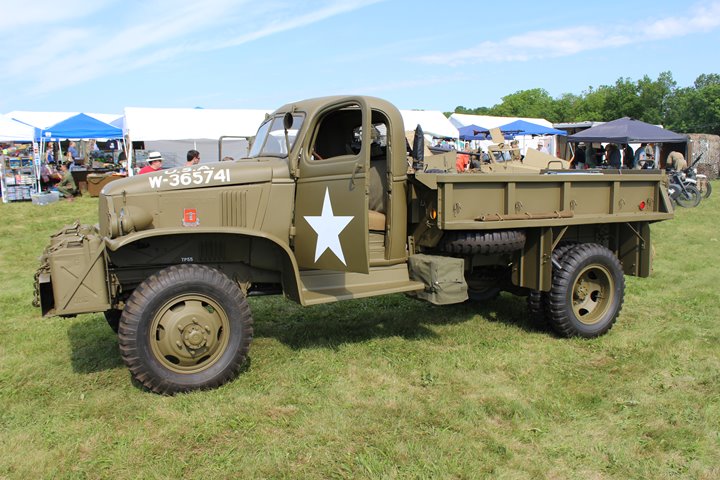
This Chevrolet dump truck was built between
1942 and 1944. Author's photo added 6-14-2017.
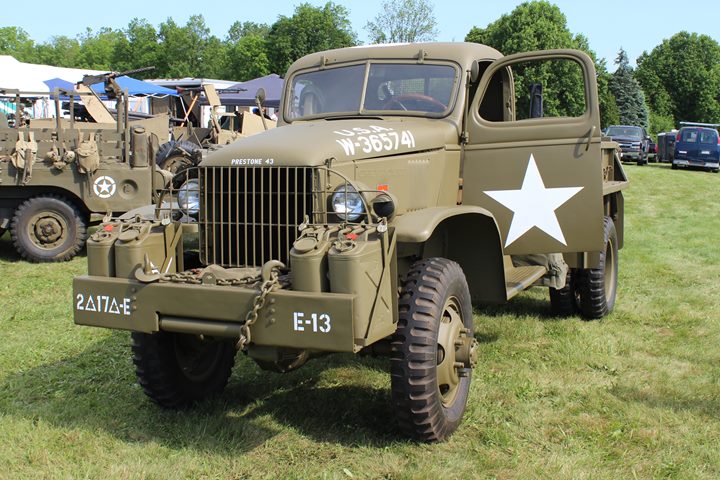
Author's photo added 6-14-2017.
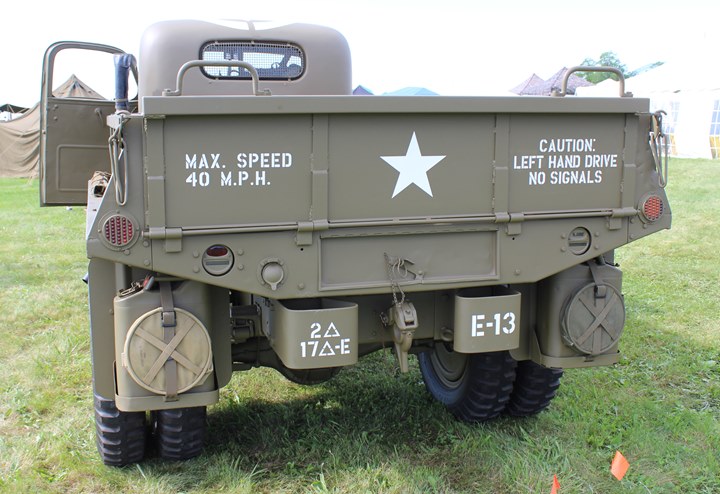
Author's photo added 6-14-2017.
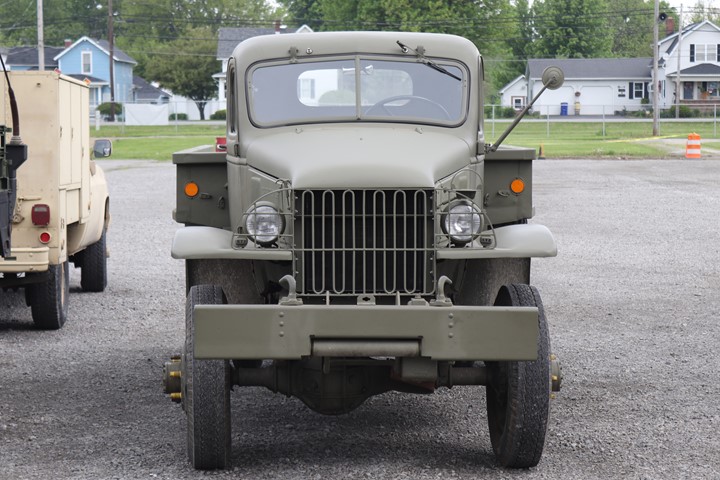
This Chevy dump truck was on display at the 2019 Findlay, OH Military
Show. Author's photo added 6-20-2019.
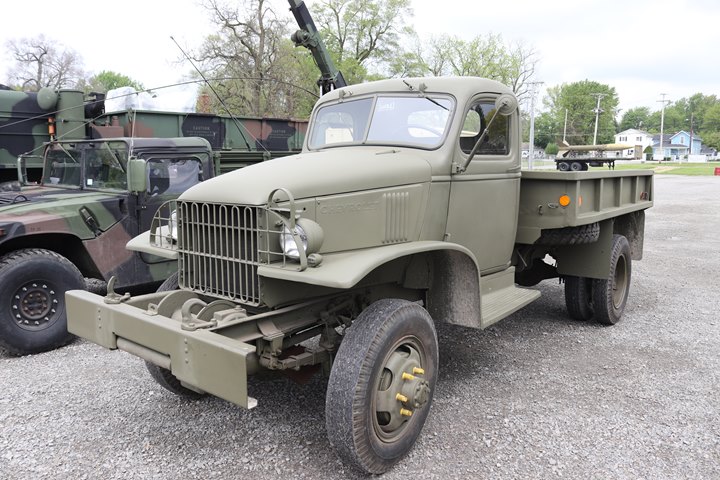
Author's photo added 6-20-2019.
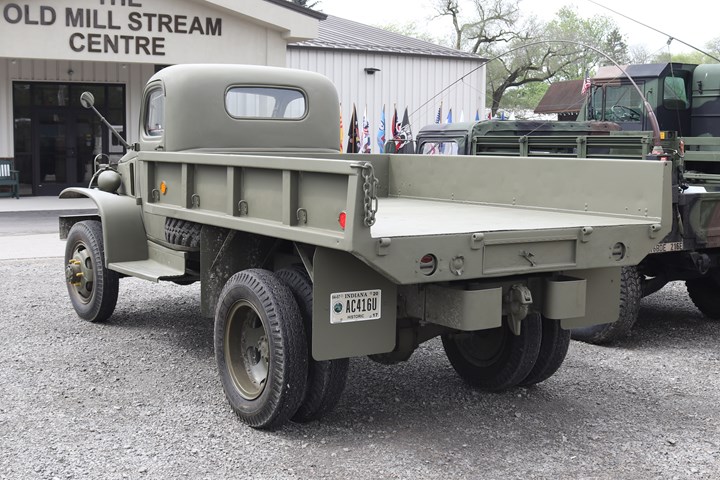
Author's photo added 6-20-2019.
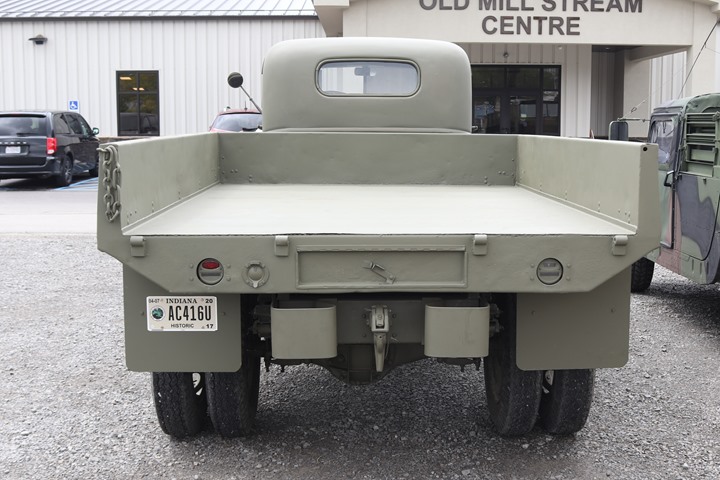
Author's photo added 6-20-2019.
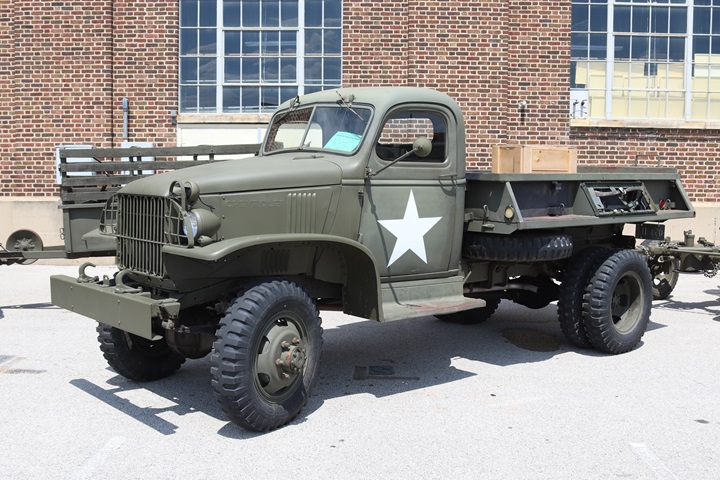
This Chevrolet dump truck was on display at
the 2019 MVPA Convention in York, PA. Author's photo added
11-20-2020.
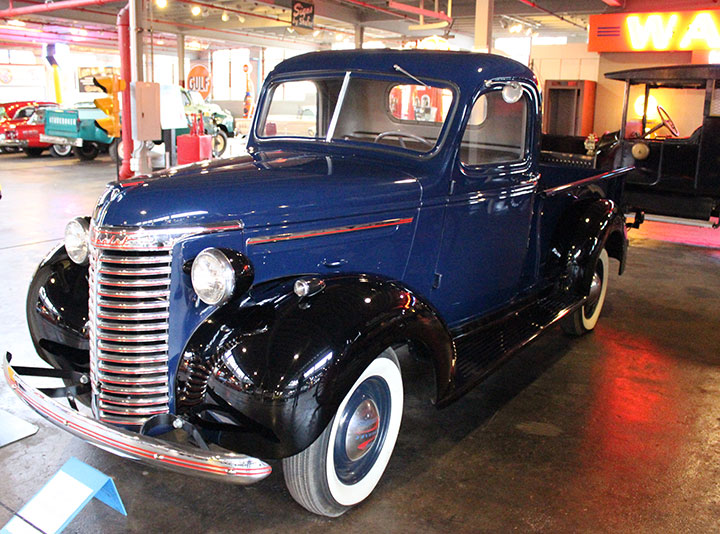
This 1942 Chevrolet 1/2 ton pickup truck
shows the Chevy styling of this type of vehicle at the time. The
truck is rare due to production of civilian vehicles being stopped in
early 1942. This vehicle was on display at the National Automotive and Truck Museum (Natmus) in
Auburn, IN. Author's photo.
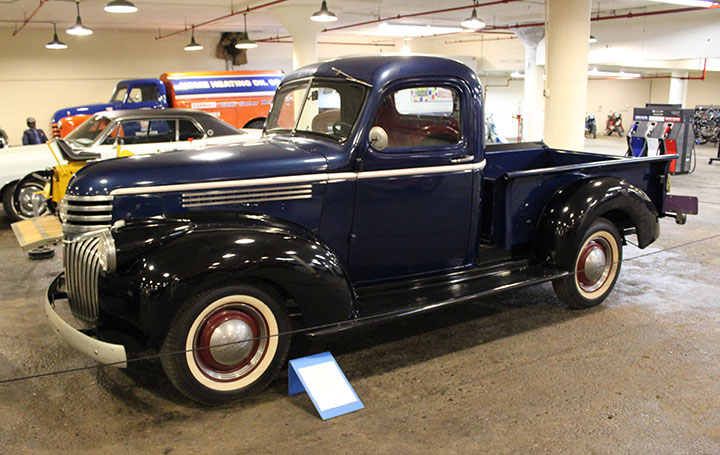
This 1946 Chevrolet 1/2 ton, also at Natmus, shows the same basic styling as the prewar model. Author's photo.
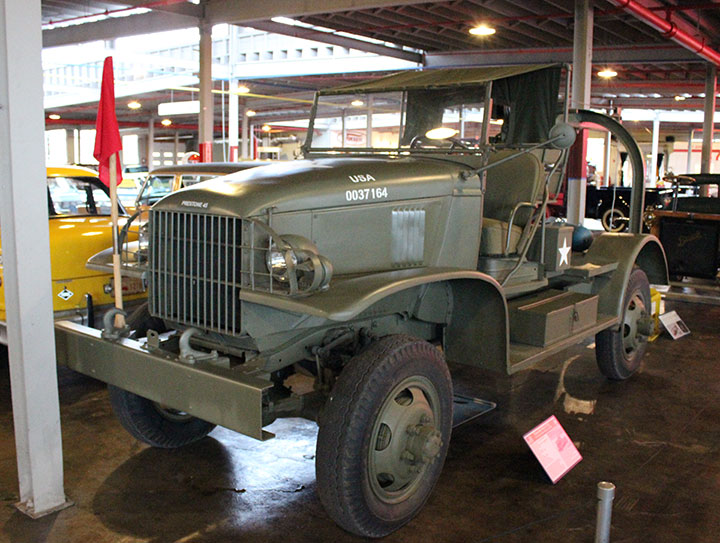
This is an example of one of the 7,857
Chevrolet-built 1-1/2 ton 4x4 bomb service trucks for the military
during World War Two. This was on display at the
National Automotive and Truck Museum in Auburn, IN. Author's
photo.
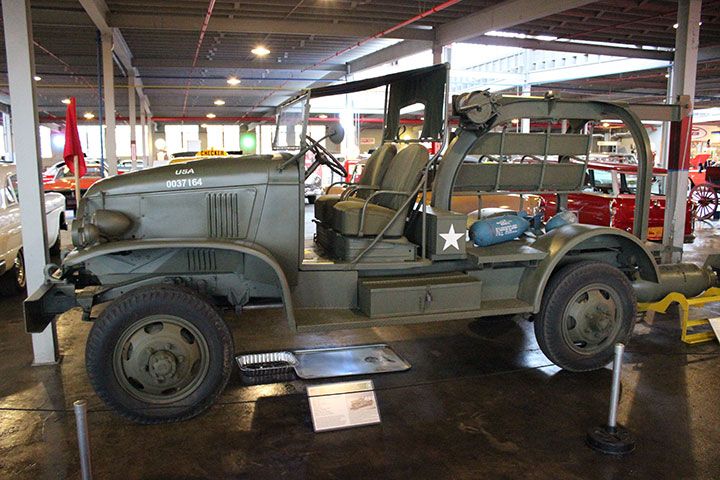
Author's photo.
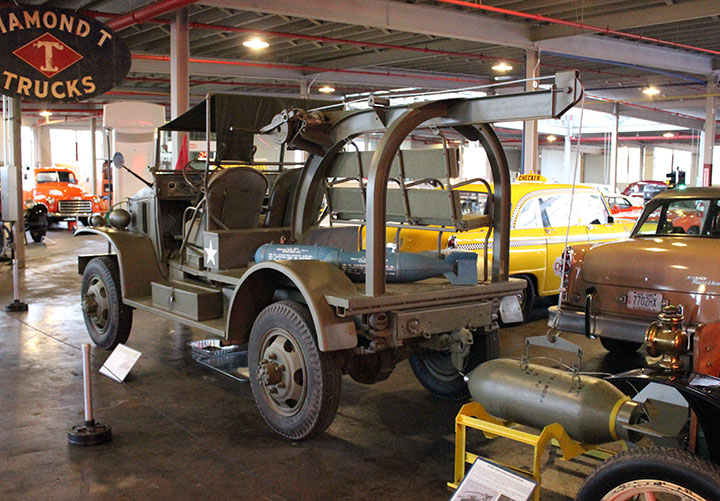
Note that there are three seats for crew
members on the passenger side of the vehicle. Author's
photo.
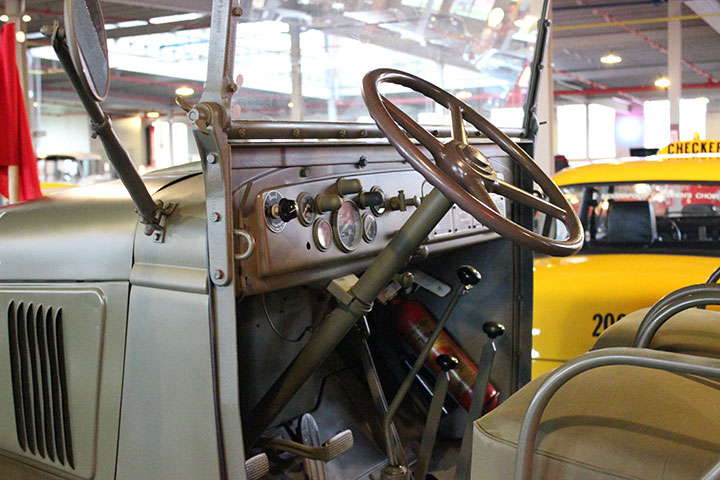
Author's photo.
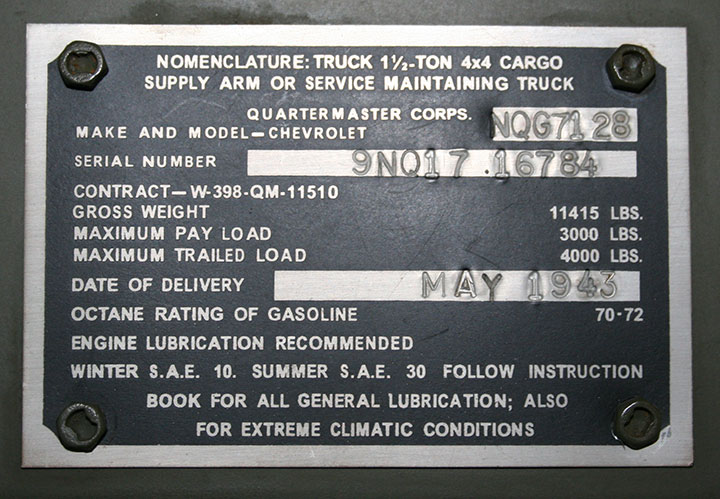
The first number 9 in the serial number
designates the Chevrolet Norwood, OH plant.
"NQ" designates it as a bomb service truck. Author's
photo.
The next set of period photos shows Chevrolet
1-1/2 ton trucks being used to train Army Air Force aircraft turret
gunners, allowing the trainees to shoot at targets while moving on the
bed of the vehicles. This is a little known but important use for
Chevrolet trucks during World War Two.
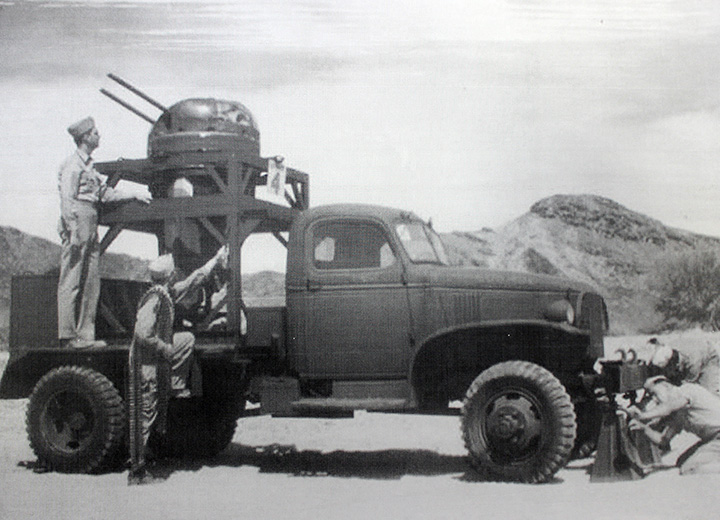
The Army Air Force designated the turret
mounted truck as an E-5. The air gunnery ranges were located at
Buckingham Army Air Field, FL, Harlingen Army Air Field, TX, Las
Vegas Army Air Field, NV, Lowry Bombing and Gunnery Range, CO, Matagorda
Island Bombing and Gunnery Range, TX, Tonopah Bombing and Gunnery Range,
NV, Tyndall Army Air Field, FL and Williams Army Air Field, AZ. Photo added 2-12-2015.
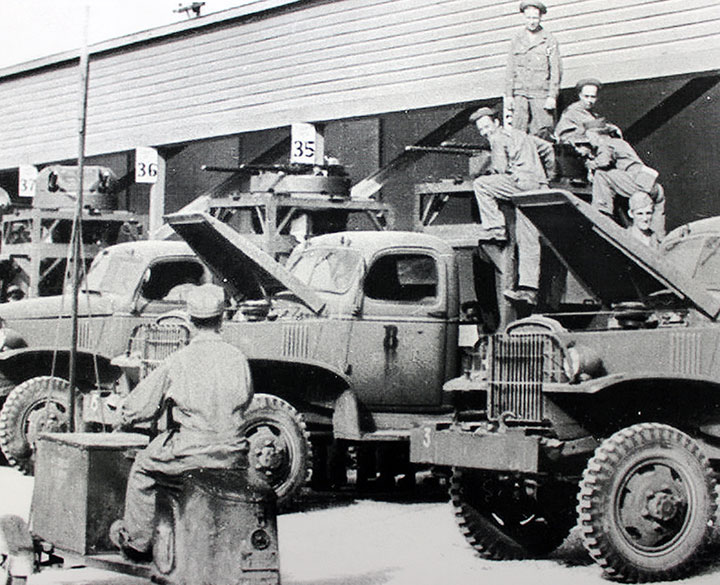
This photo of the E-5 gun trainer was taken
at Buckingham Army Air Field, located east of Fort Meyers, FL. Photo added 2-12-2015.
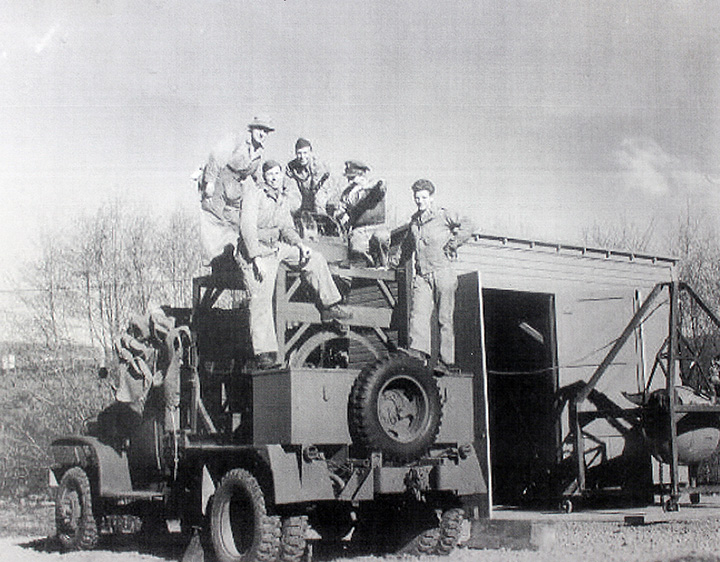
Photo added 2-12-2015.
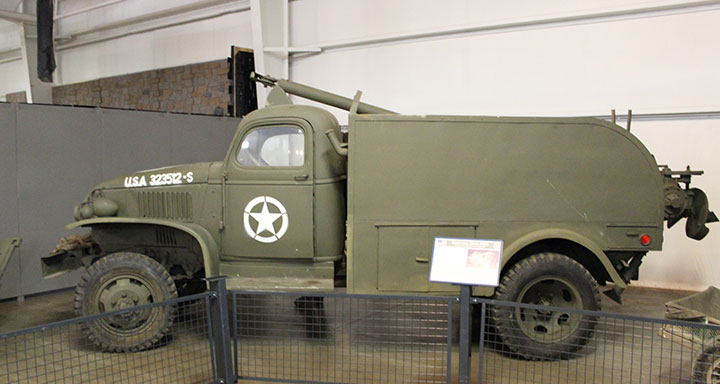
This is another example of the Chevrolet
1-1/2 ton 4x4 trucks built for the military during the Second World War.
This one is a telephone pole setter, formerly at the National Military History
Center in Auburn, IN. Author's photo.
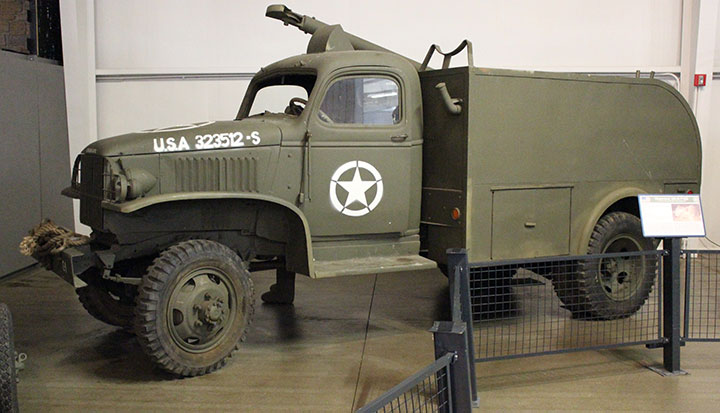
Chevrolet built 1,719 of these during
World War Two. Author's photo.
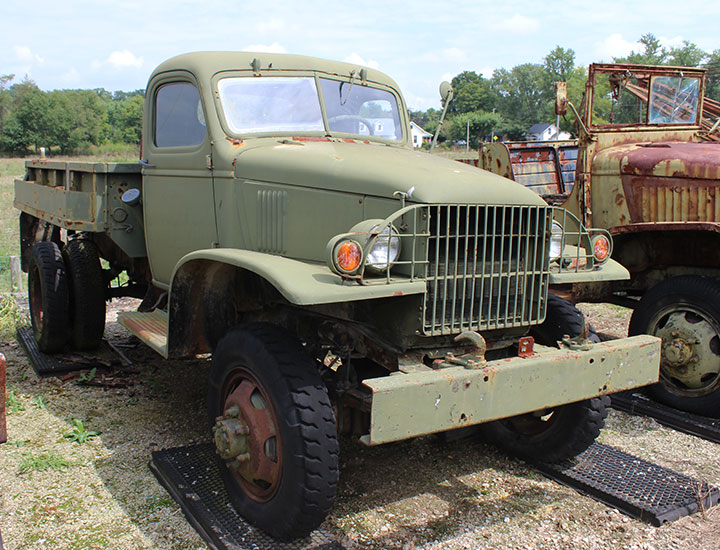
This photo of a derelict Chevy 1-1/2 ton
truck was taken
at the Fort Economy Museum in Hallsville, OH. Author's photo added
9-2-2014.
Crash and Fire Trucks built on Chevrolet
4x4 Chassis:
Chevrolet 1-1/2-ton 4x4 Military Crash and Fire Trucks
Information in this table courtesy of "Chevrolet G-506" by
David Doyle. |
|
Class |
Registration Number |
Quantity |
Apparatus Manufacturer |
Comments |
|
110 |
50702-50731 |
30 |
Holabird Quartermaster Depot |
Hale
pumps |
|
501274-501428 |
157 |
Holabird and Memphis Quartermaster Depot |
American LaFrance pumps |
|
503961-504000 |
40 |
Oren
Fire Apparatus |
|
|
503769-503918 |
150 |
Army
Corps of Engineers |
|
|
Total Class 110 |
|
377 |
|
|
|
135 |
506089-506138 |
50 |
W.S Darley |
|
|
5010139-5010238 |
100 |
|
|
506239-506338 |
100 |
Mack |
|
|
507843--597992 |
150 |
|
|
507347-507377 |
31 |
Oren Fire Apparatus |
|
|
508332-508431 |
100 |
|
|
507478-507527 |
50 |
Minnesota Fire Equipment Company |
|
|
5075780-507602 |
25 |
|
|
507528-507577 |
50 |
Central Fire Trucks Corporation |
|
|
5010029-5010088 |
60 |
American LaFrance |
|
|
Total Class 135 |
|
716 |
|
|
| 300 |
Unknown |
Unknown |
Central Fire Trucks Corporation |
These
were equipped with W.S. Darley Model F-300 front-mounted pumps
and carried a 250-gallon water tank. |
| 325 |
Unknown |
Unknown |
W.S
Darley, Detroit General Corporation, American Fire Apparatus,
Hahn, Oren, and Maxim Motors |
These
were equipped with Barton Model F-300 or W.S. Darley Model F-300
front-mounted pumps and carried a 300-gallon water tank. |
| 525 |
Unknown |
Unknown |
Oren
Fire Apparatus |
These
were equipped with W.S. Darley Model F-500 front-mounted pumps. |
|
Known Total U.S. Army |
|
1,093 |
|
|
|
U.S. Navy |
|
|
|
|
| U.S.
Navy |
|
103 |
Howe
Fire Apparatus Company |
|
|
Total U.S. Navy |
|
103 |
|
|
|
Known Grand Total |
|
1,196 |
|
|
Class 110
Crash and Fire Trucks built on Chevrolet 1-1/2 ton 4x4 Chassis:
As noted above, the 377 bodies were
built by the Holabird and Memphis Quartermaster Depots, Oren Fire
Apparatus, and the Army Corps of Engineers. It
is unknown which organization built the bodies in the photos below.
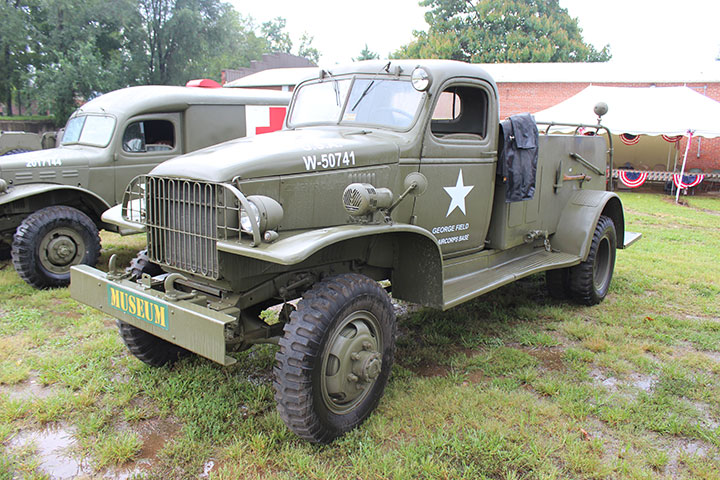
This Chevrolet-built 1-1/2 ton 4x4 Class 110 crash truck actually served at George
Army Air Field in Lawrenceville, IL during World War Two. The truck belongs
to the Indiana Military Museum in nearby Vincennes, IN, eleven miles away
from the old air field.
Author's photo added 9-2-2014.
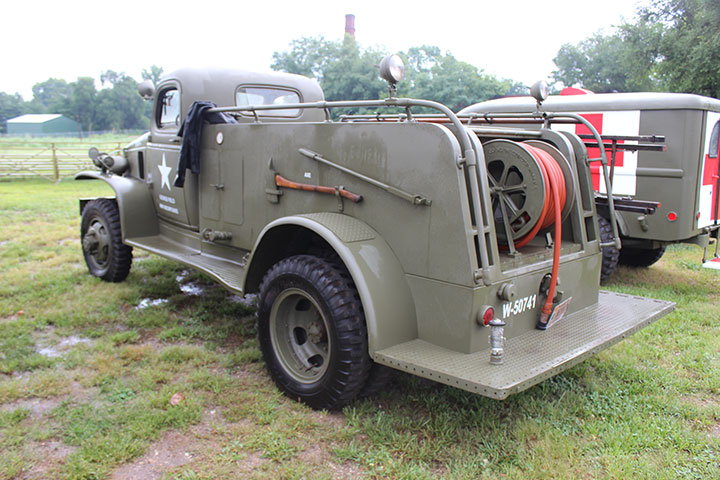
Through the end of 1942, Chevrolet provided 306 of these crash truck
bodies
for the army.
Author's photo added 9-2-2014.
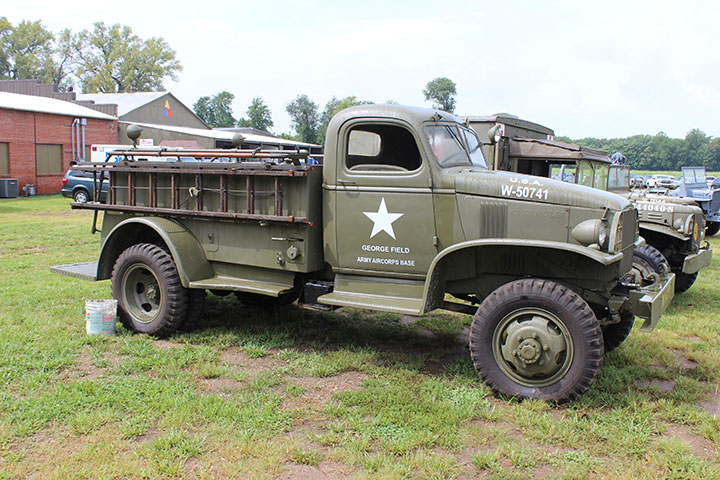
Author's photo added 9-2-2014.
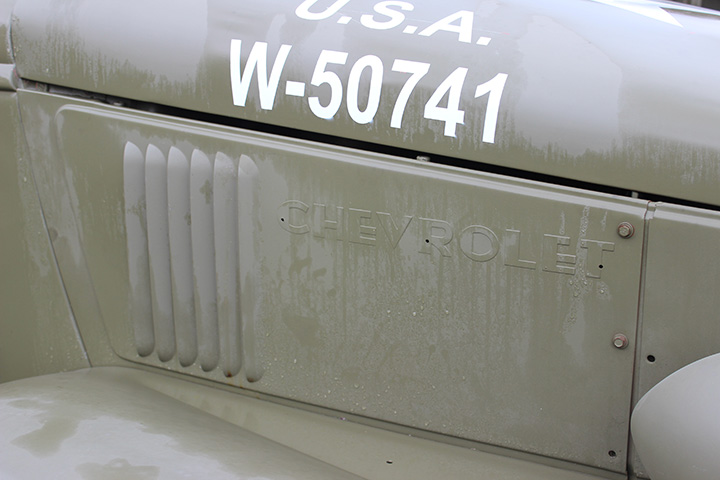
The registration number on the hood does not
match any in the table above. If it were W-50731, the body
would have been built by the Holabird Quartermaster Depot. Author's photo added 9-2-2014.
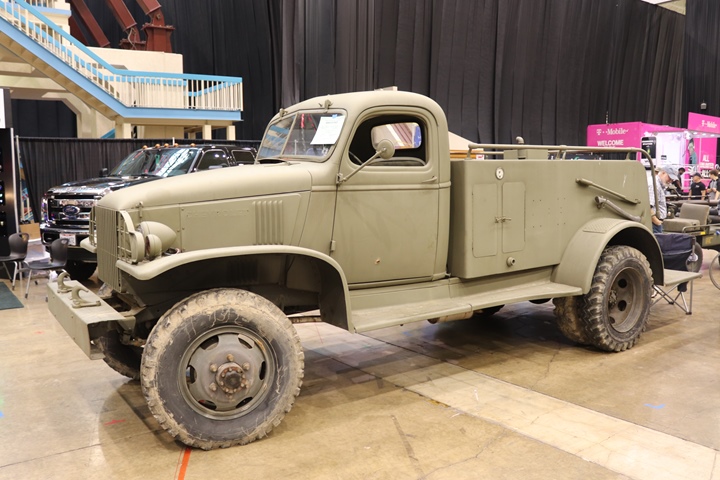
This 1942 Chevrolet Class 110 crash truck was
photographed at the 2017 MVPA national convention in Cleveland, OH.
It is Serial Number N90212859. Author's photo added 12-25-2019.
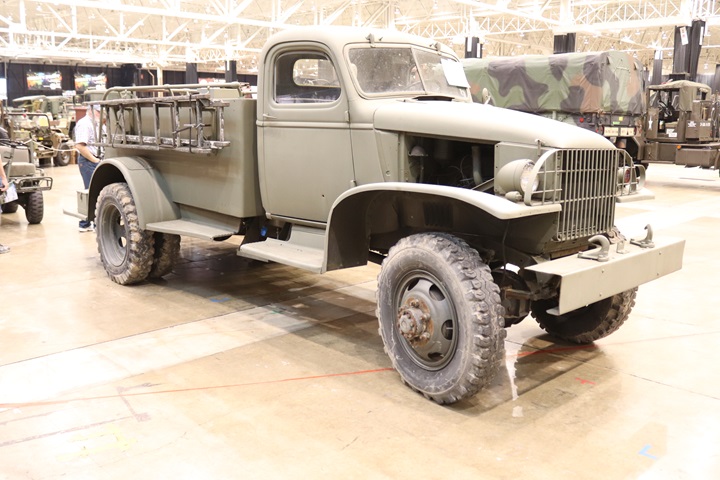
Author's photo added 12-25-2019.
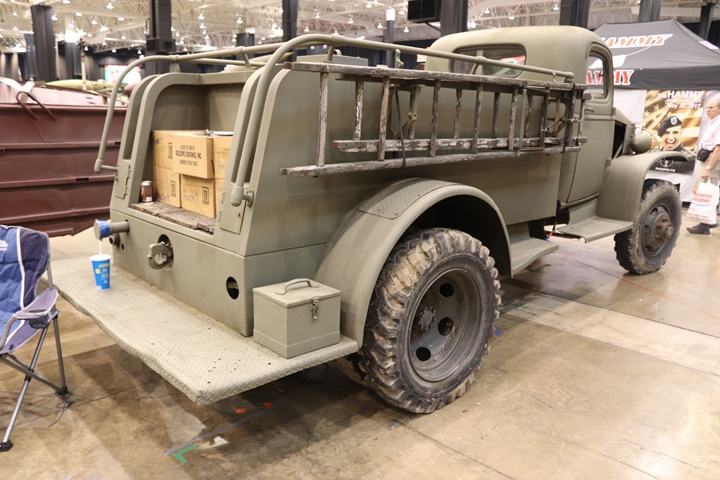
Author's photo added 12-25-2019.
Class 125 Crash and Fire Trucks built on
Chevrolet 1-1/2-ton 4x2 civilian truck chassis: The Chevrolet
class 125 crash truck shown below is an anomaly. According to the
historical record, only International Harvester Corporation provided the
chassis for the Class 125 crash truck. The example below shows
that they were also built on Chevrolet chassis.
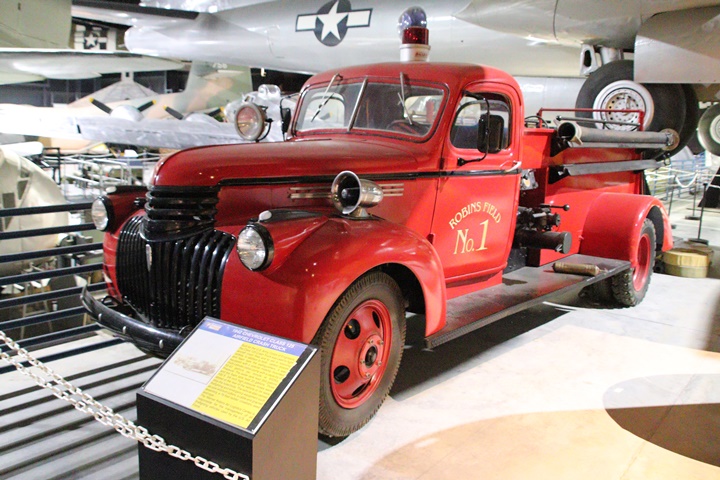
This 1942 Chevrolet truck was used as a
class 125 fire truck at Robins Field during World War Two. It is
on display at the Museum of Aviation at Robins Air Force Base, GA.
Author's photo added 6-14-2022.
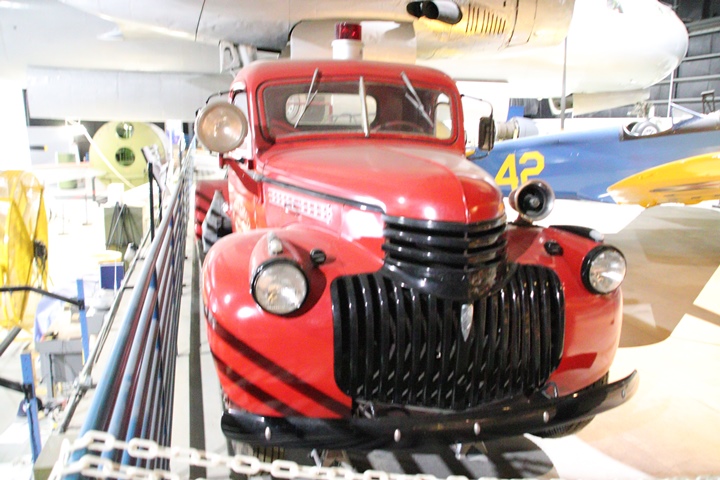
Author's photo added 6-14-2022.
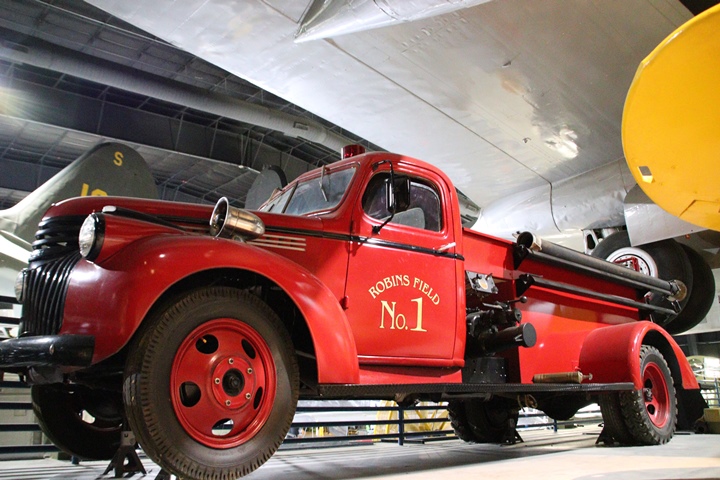
Author's photo added 6-14-2022.
Class 135 Crash and Fire Trucks built on
Chevrolet 1-1/2 ton 4x4 Chassis: As noted above, the 377 bodies
were built by W.S Darley, Mack, Oren Fire Apparatus, Minnesota Fire
Equipment Company, Central Fire Trucks Corporation, and American
LaFrance.
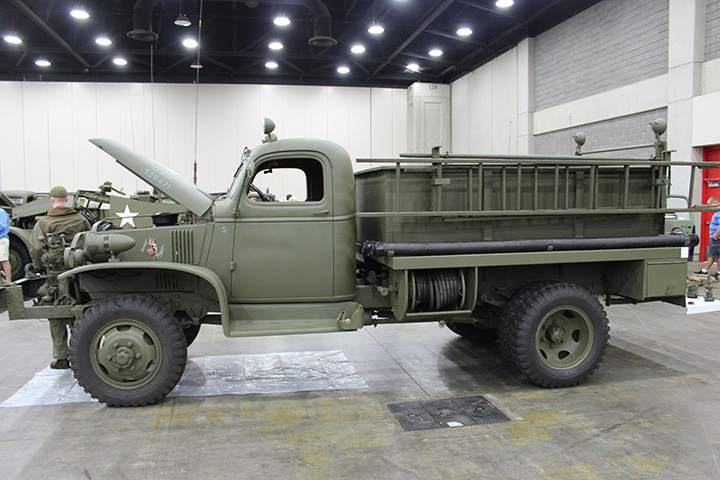
This 1943 Chevrolet 1-1/2-ton 4x4 Class 135 fire truck was on display at
the annual MVPA Convention at Louisville, KY in June 2014. The registration
number 508421 indicates the body was built by Oren Fire Apparatus. Author's photo added
9-2-2014.
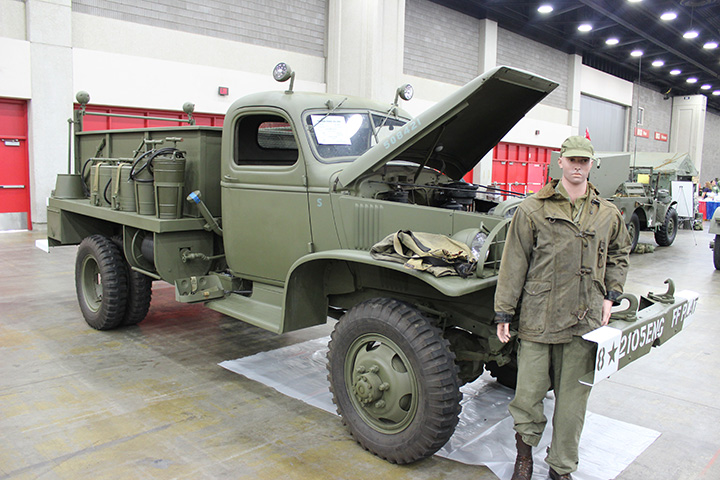
Author's photo added 9-2-2014.
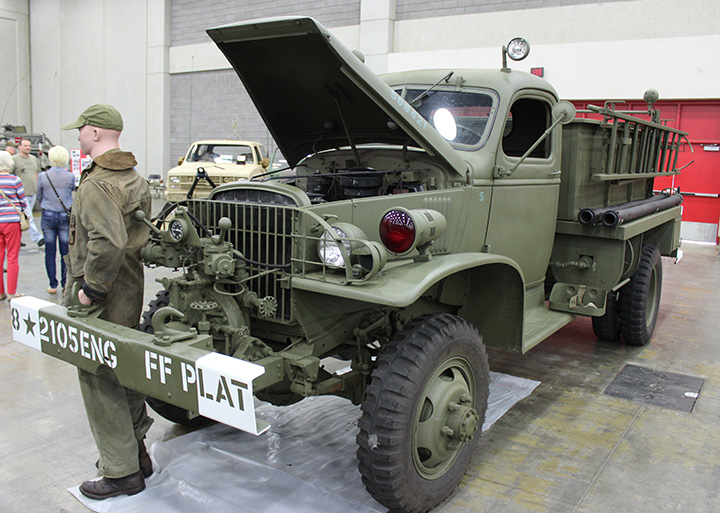
Author's photo added 9-2-2014.
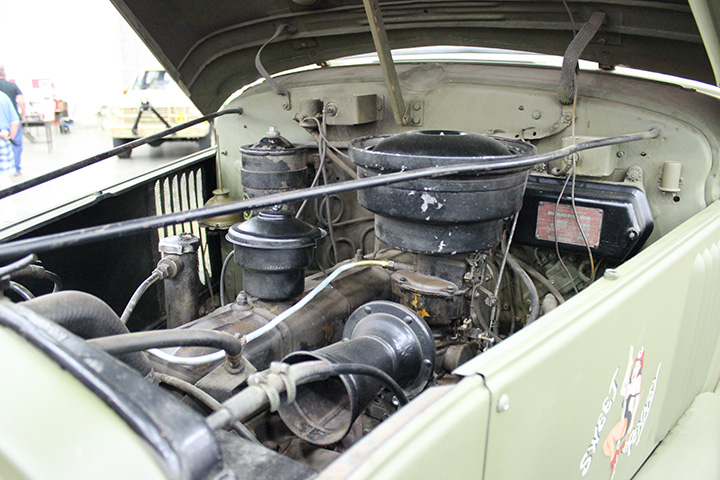
Author's photo added 9-2-2014.
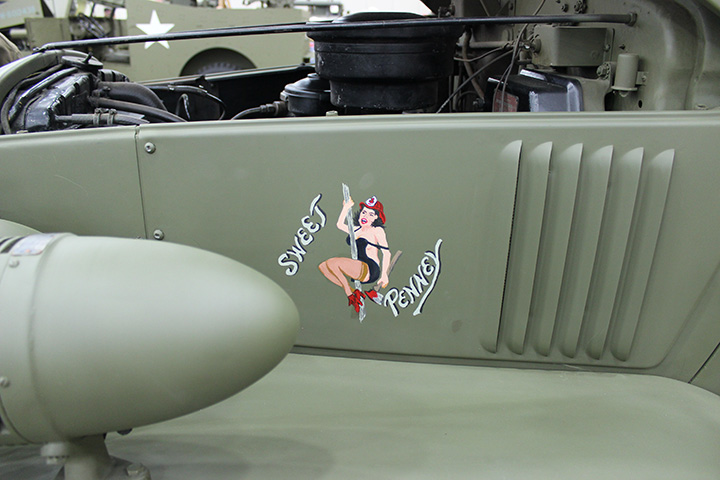
Author's photo added 9-2-2014.
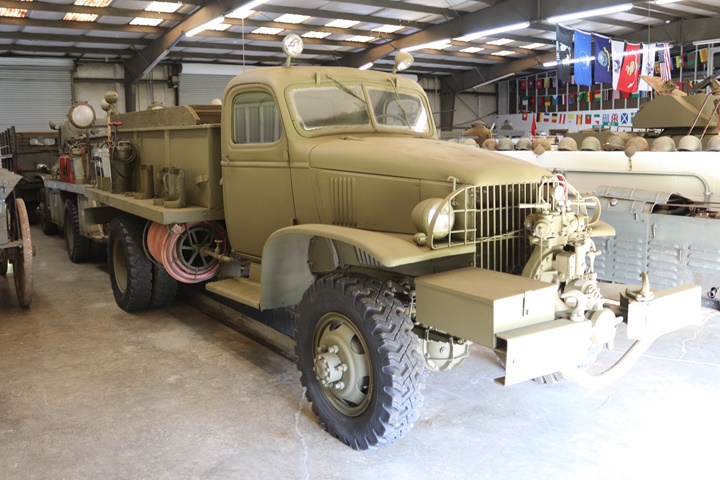
This Class 135 is one of two Chevrolet World War Two
crash trucks on display at the Sam
Werner Military Museum. The second one is parked directly behind this one.
It is a Class 325.
Author's photo added 11-20-2020.
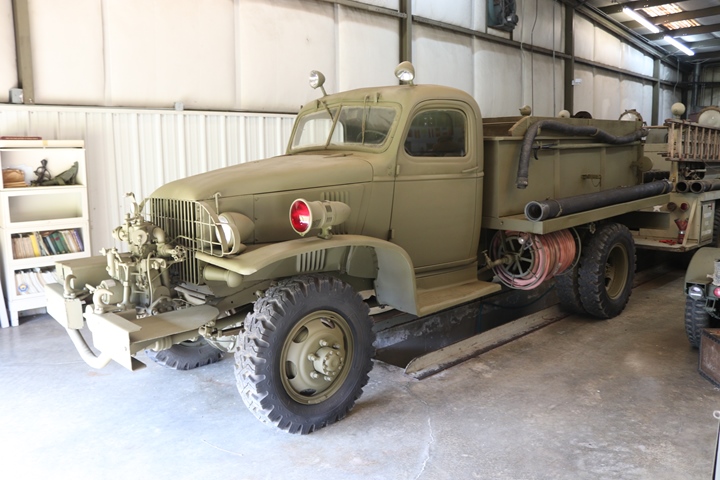
Author's photo added 11-20-2020.
Class 325 Crash and Fire Trucks built on
Chevrolet 1-1/2 ton 4x4 Chassis: As noted above, the bodies were
built by W.S. Darley, Detroit General Corporation (General Fire
Truck), American Fire Apparatus, Hahn, Oren, and Maxim Motors.
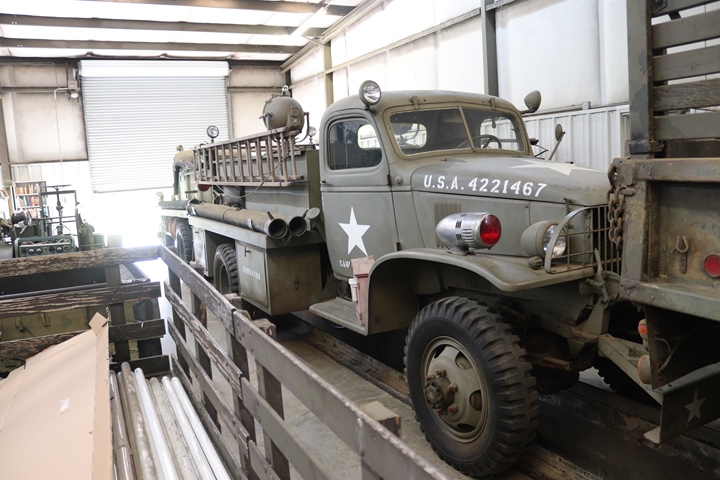
This is the second Chevrolet crash truck at
the Sam Werner Military Museum. It is a Class 325 with a General Fire Truck body. The USA
registration number is incorrect. It should start with a "50." Author's photo added 11-20-2020.
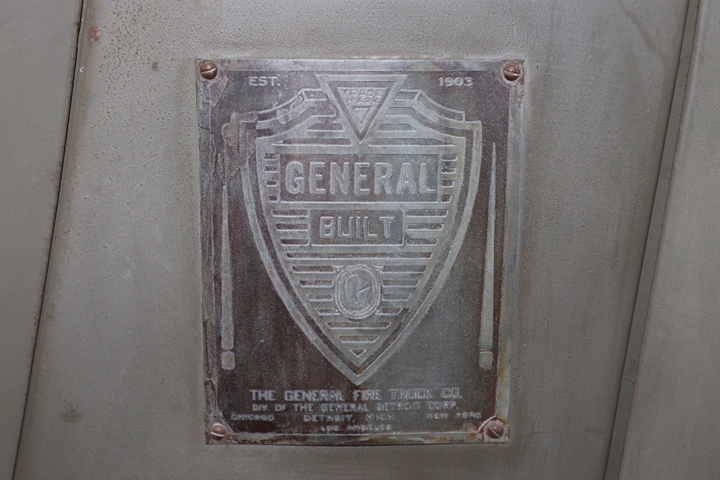
Author's photo added 8-26-2021.
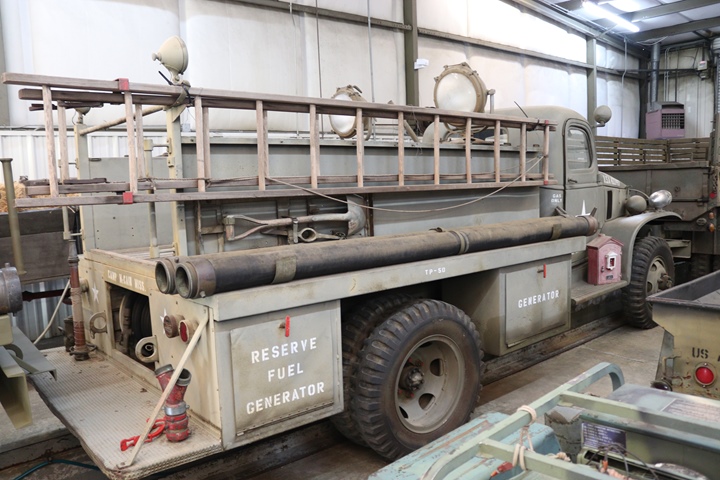
Author's photo added 11-20-2020.
Amphibious Trucks (DUKW):
The Chevrolet St. Louis plant built (6,748) GMC name plated DUKWs.
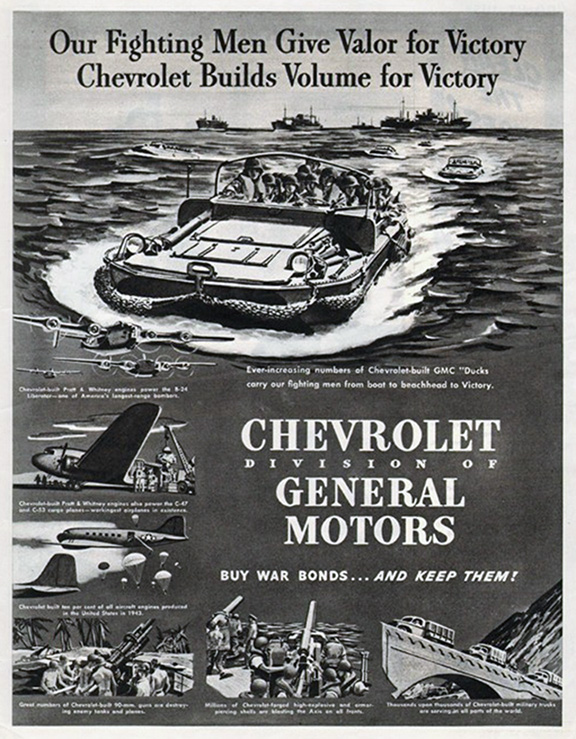
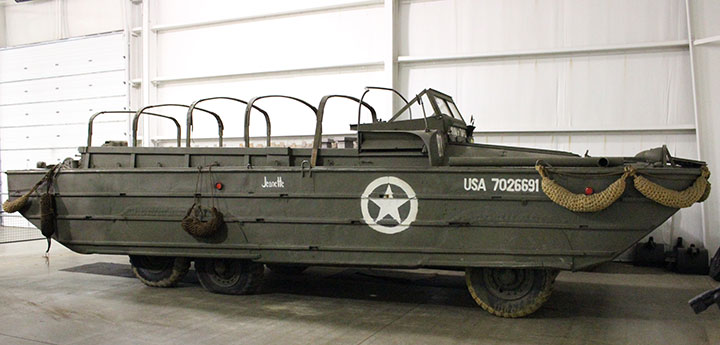
This DUKW was on display at the National
Military History Center in Auburn, IN. It is no longer there. Author's photo.
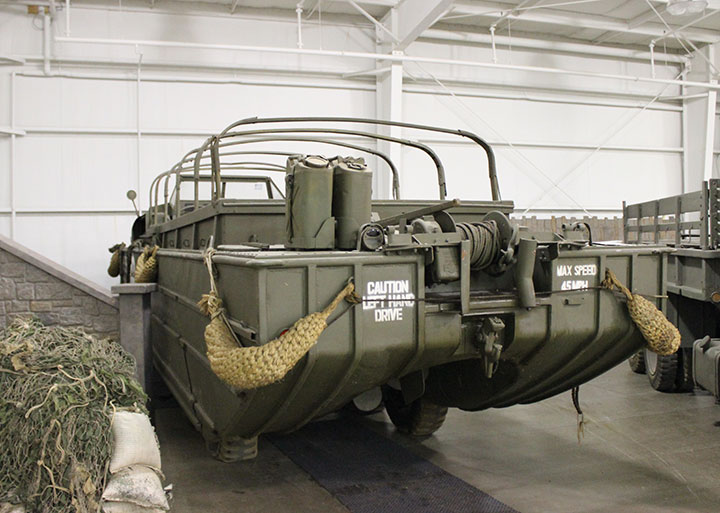
Author's photo.
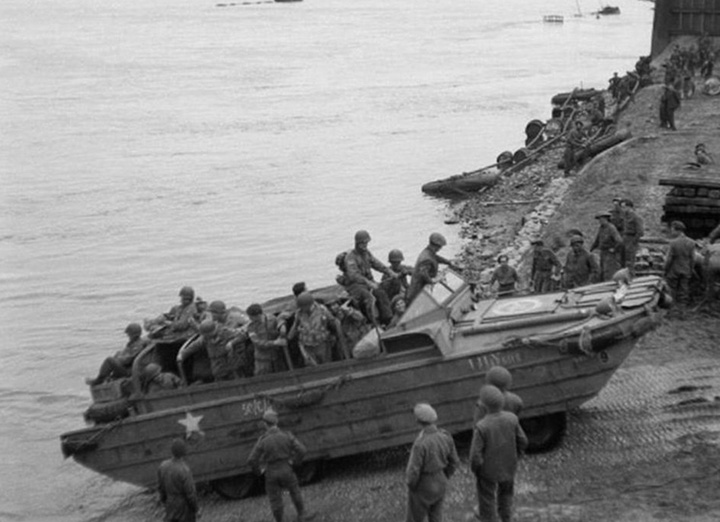
In this World War Two era photo, the DUKW shows its
versatility in a river crossing.
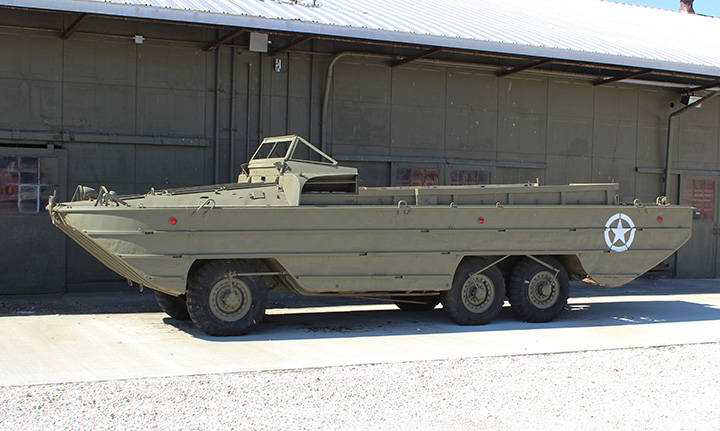
This DUKW is on display at the Indiana
Military Museum in Vincennes, IN. Author's photo.
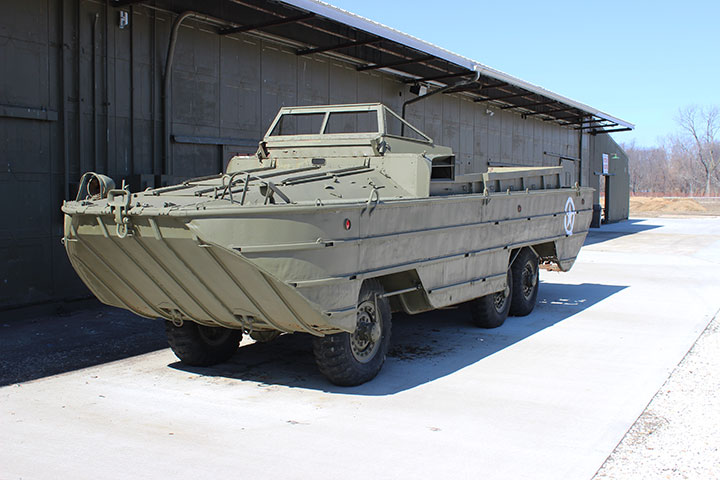
Author's photo.
Aircraft Engines:
56,484 R-1830 and 4,282 R-2800 Pratt & Whitney
Radial Aircraft Engines. Seventeen Chevrolet plants provided
components that went into the final
assembly at Tonawanda, NY.
R-1830 - Chevrolet Tonawanda built the
first of 56,484 R-1830s on 3-20-1942 and continued to produce the engine
until 3-31-1945. During these three years, Tonawanda turned out an
average of 1,569 engines per month. Chevrolet built R-1830s that were used in the B-24, C-82, PBY, and A-28.
Buick also built the R-1830 during World War
Two. It produced 74,198 in a government-owned plant in Melrose Park, IL,
west of Chicago. Chevrolet and Buick combined to provide 130,682
R-1830s, which was 75% of the 173,618 built during the war. General
Motors was the largest producer of the R-1830 during World War Two.
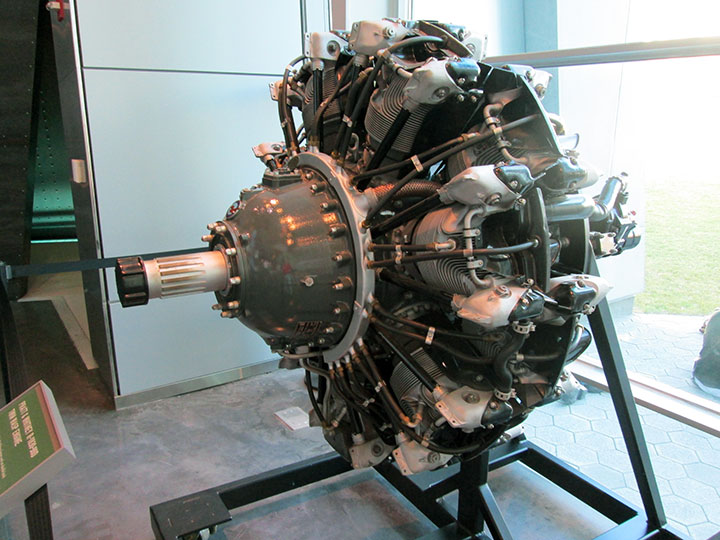
This is a Pratt & Whitney R-1830 engine,
as seen at the National Museum of World War Two in New Orleans, LA. Chevrolet Tonawanda built this
type of aircraft engine. Author's photo.
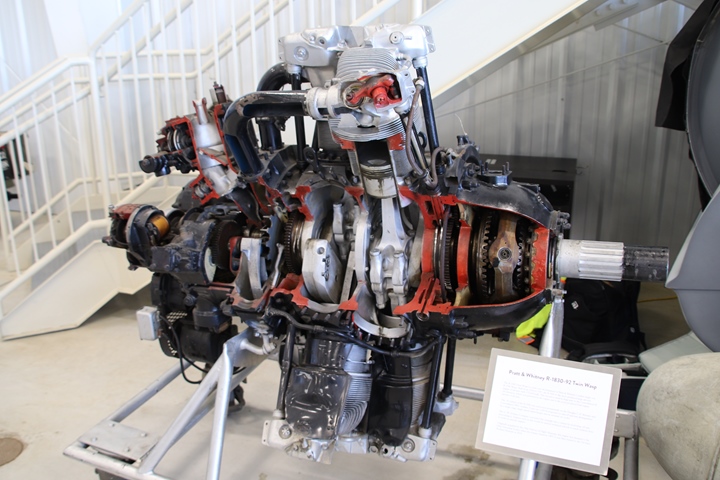
This R-1830 display at the Tri-State Warbird
Museum in Batavia, OH shows the complexity of the engine. Author's
photo added 11-20-2020.
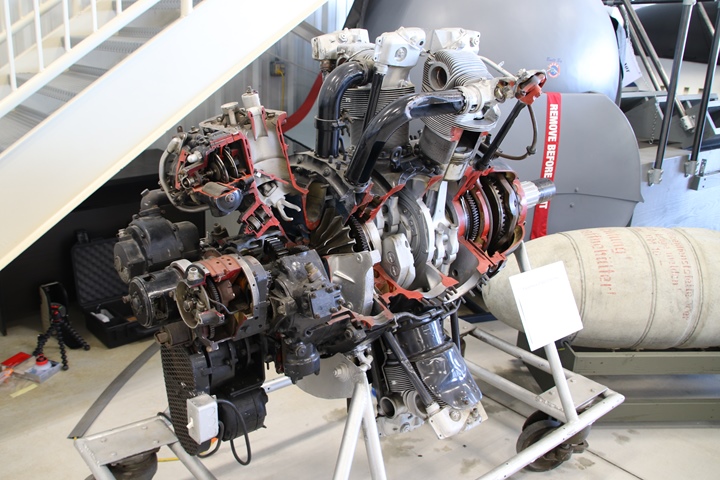
Author's photo added 11-20-2020.
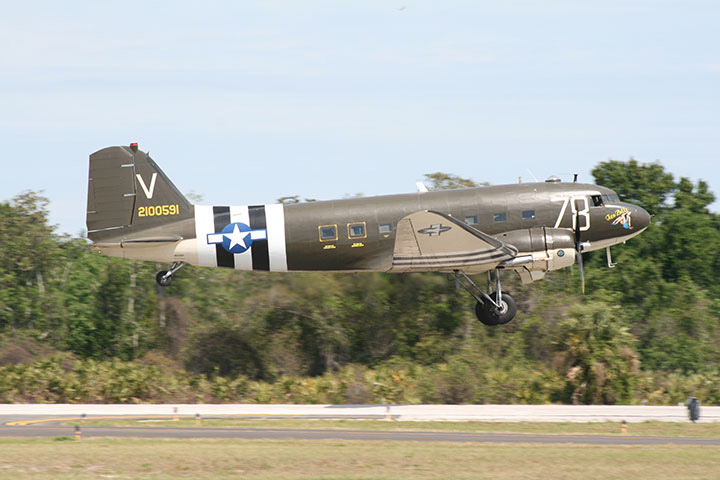
Chevrolet Tonawanda-built
Pratt & Whitney engines went into the Douglas C-47, the workhorse
transport aircraft for the United States during World War Two. Author's
photo.
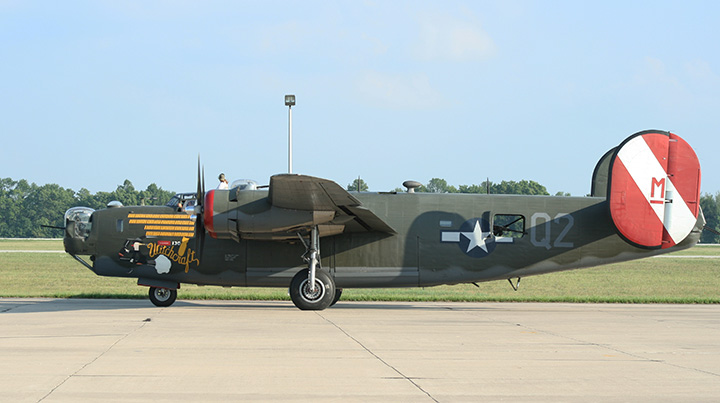
Chevrolet-built R-1830s were used in the
B-24. The C-82 was the cargo version of the B-24. Author's
photo added 11-20-2020.

This is a USAAF OA-10, which was its
designation for a PBY. Tonawanda was only providing engines for the USAAF, so it was probably this version of the aircraft in which the
engines were used. Author's photo added 11-20-2020.
R-2800 - Chevrolet built the first of
4,282 R-2800 aircraft engines on 7-29-1944. It maintained a
production run of 356 per month until a year later when the war ended.
These were used on the P-47, P-61, A-26, C-46, and C-82. The first
engine was built in only five months and nineteen days from start to
final testing and acceptance. This was extremely fast for such a
complex engine.
|
Chevrolet-Built Pratt & Whitney R-2800 Engines |
|
R-2800 Model |
Number of Engines Built |
Aircraft Type |
|
R-2800-57 |
200 |
P-61C,D; P-47M,N |
|
R-2800-73 |
2,665 |
P-61C; P-47N |
|
R-2800-77 |
500 |
P-61C,D; P-47N |
|
R-2800-83 |
855 |
This was for the A-26D which was cancelled due to the ending of
World War Two. The engine was later used in the
Vought AU-1 developed during the Korean Conflict. |
|
R-2800-85 |
62 |
C-82A.
Some were built during World War Two |
| Total |
4,282 |
|
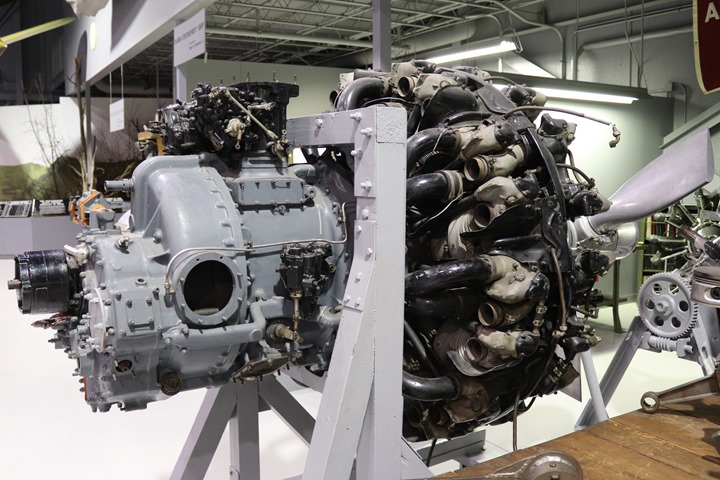
This R-2800 is on display at the EAA Museum
in Oshkosh, WI. While the R-1830 had a single row of nine
cylinders, the R-2800 had two rows of nine cylinders. The
accessory section of the R-2800 was a whole section of the engine which the R-1830 didn't have. The R-2800 was an order of
magnitude more complex to build than the R-1830. Author's photo
added 11-20-2020.
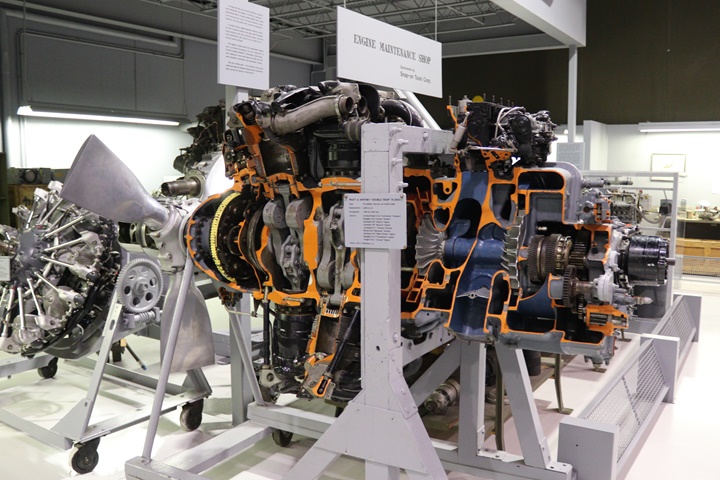
Looking at the other side of the display and
the interior of the engine, its complexity is obvious. Author's
photo added 11-20-2020.
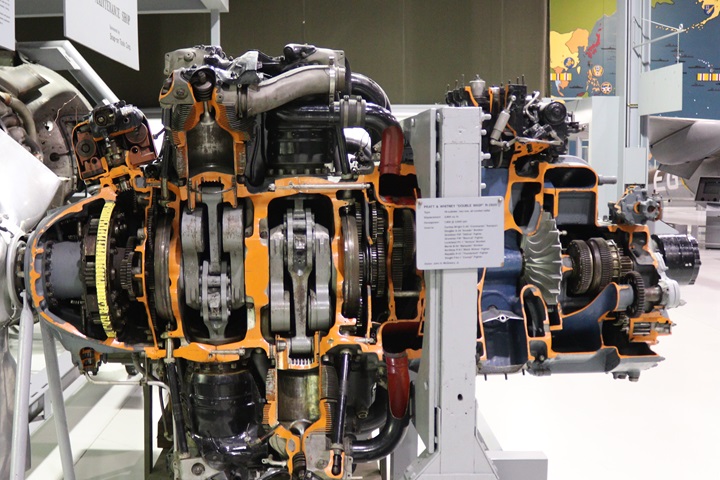
The R-2800 was the most powerful radial
engine the U.S. military used in World War Two. The R-2800 was
used in both of the Navy's premier World War Two fighters, the F6F and F4U.
Author's photo added 11-20-2020.
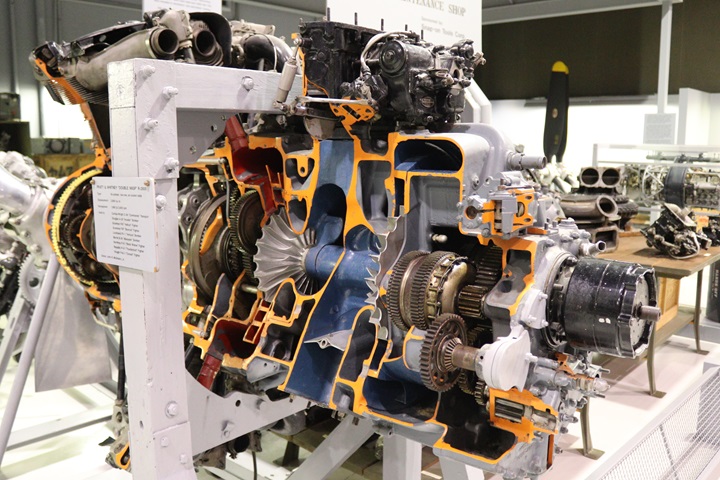
Author's photo added 11-20-2020.
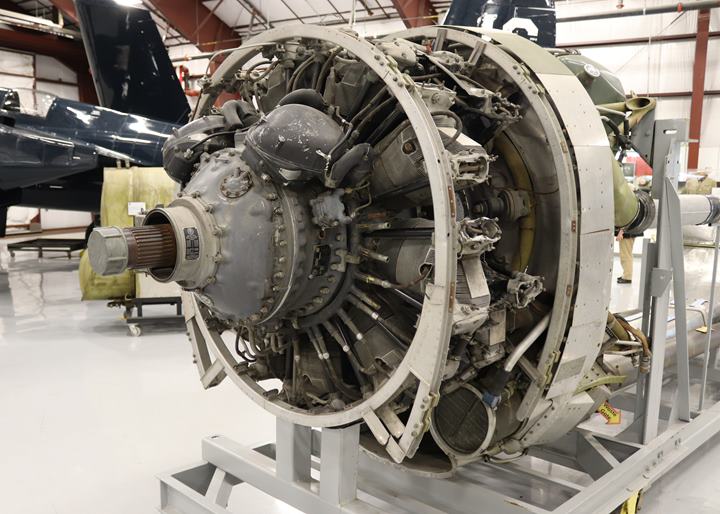
This Chevrolet-built Pratt and Whitney
R-2800 engine is on display at the National Museum of WWII Aviation in
Colorado Springs, CO. Author's photo added 10-7-2017.
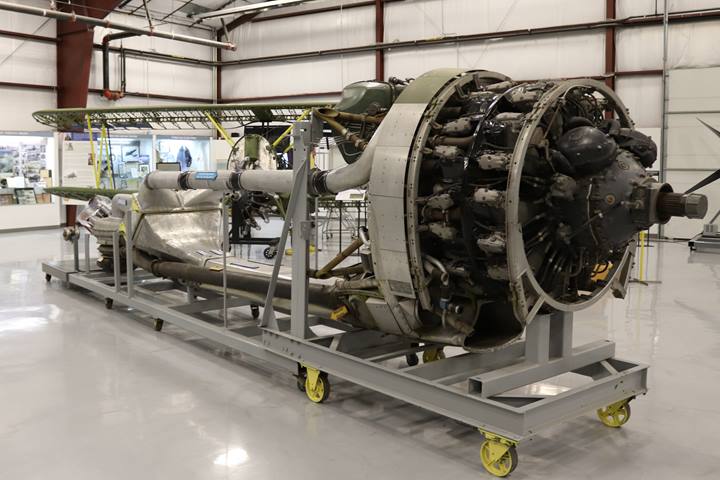
The engine is part of a larger display
showing how the Republic P-47 super turbocharger system worked. Author's photo
added 10-7-2017.
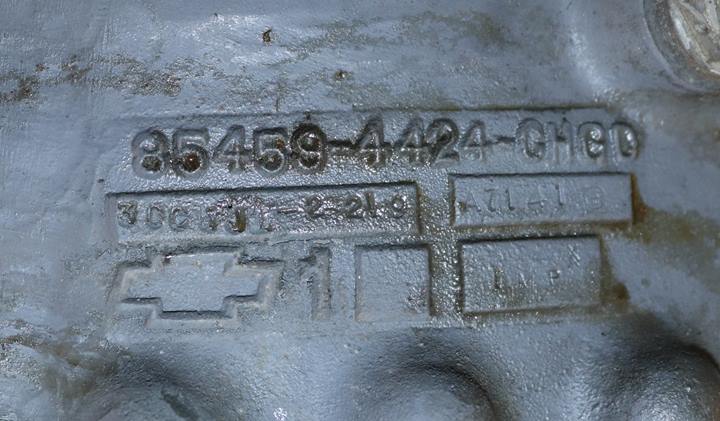
Here is the Chevrolet bowtie on the engine's
nose housing. Author's photo added 10-7-2017.
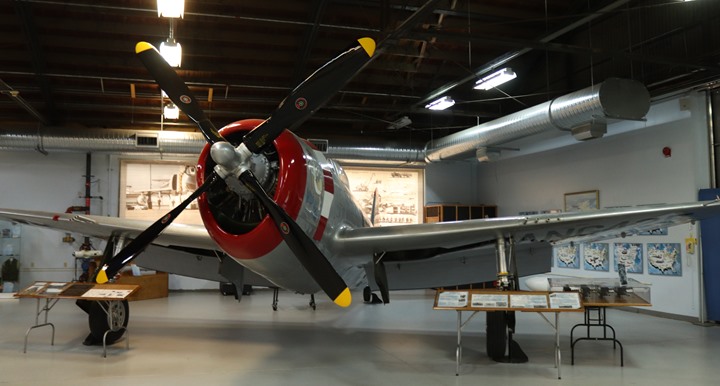
This P-47 is located at the Peterson Air and
Space Museum at Peterson AFB in Colorado Springs, CO. It has a
Chevrolet Tonawanda-built R-2800
engine in it. Author's photo added 10-7-2017.
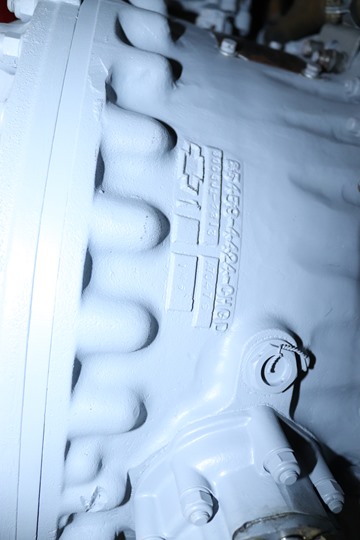
Author's photo added 10-7-2017.
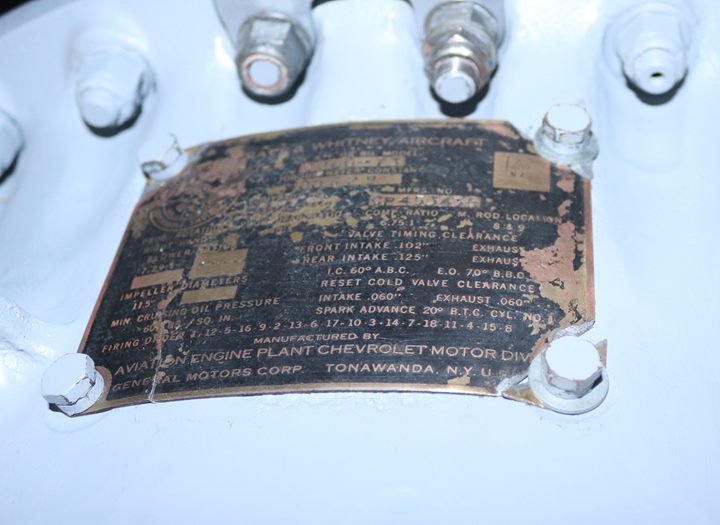
This engine still has the data plate on it.
Author's photo added 10-7-2017.
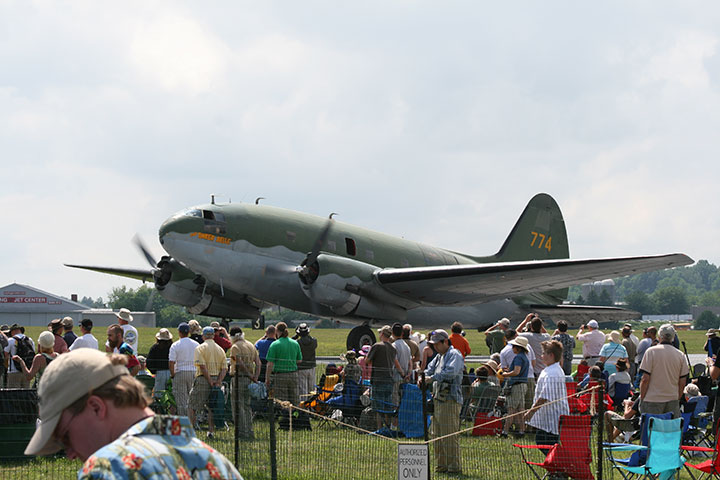
The C-46. Author's photo added
11-20-2020.
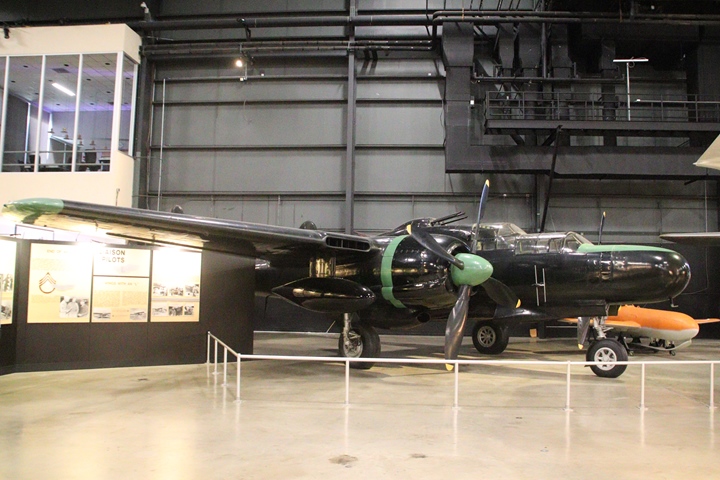
The P-61C featured the higher performance
R-2800 that Chevrolet was assigned to build. Author's photo added
11-20-2020.
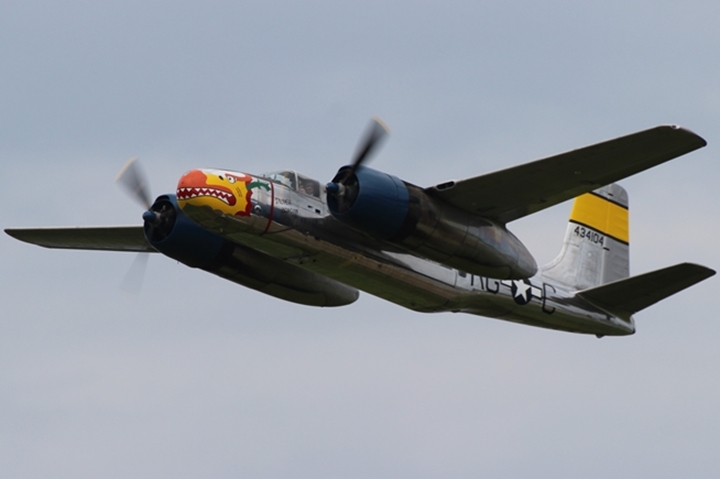
The A-26. Author's photo added
11-20-2020.
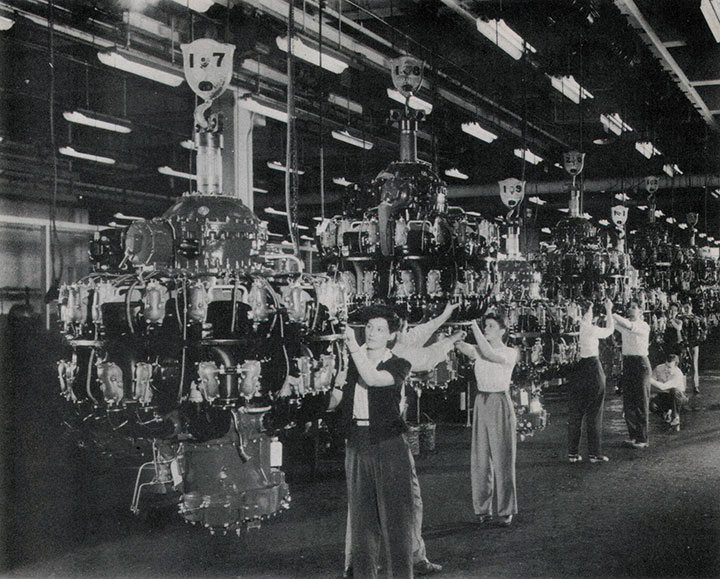
This is part of the Chevrolet Tonawanda, NY
Pratt & Whitney R-2800 radial aircraft engine production line.
Seventeen plants in the Chevrolet Division were involved in making
these aircraft engines. The Chevrolet Tonawanda plant is still
in production today. It is right along the Niagara River south of The Falls and north
of Buffalo.
Armored Cars:
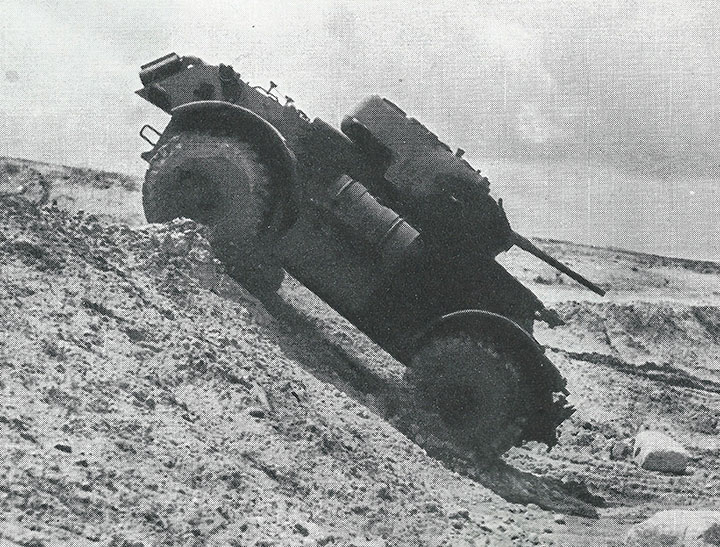
This photo of a T17E1 "Staghound" armored
car, as it appeared in the GM 1944 annual report. According to the annual
report, the Staghound was a closely guarded secret for three years.
There was also a T17E2 which replaced the 37mm cannon shown here with
two .50 caliber M2 machine guns in a Frazier-Nash turret as an
anti-aircraft mount.
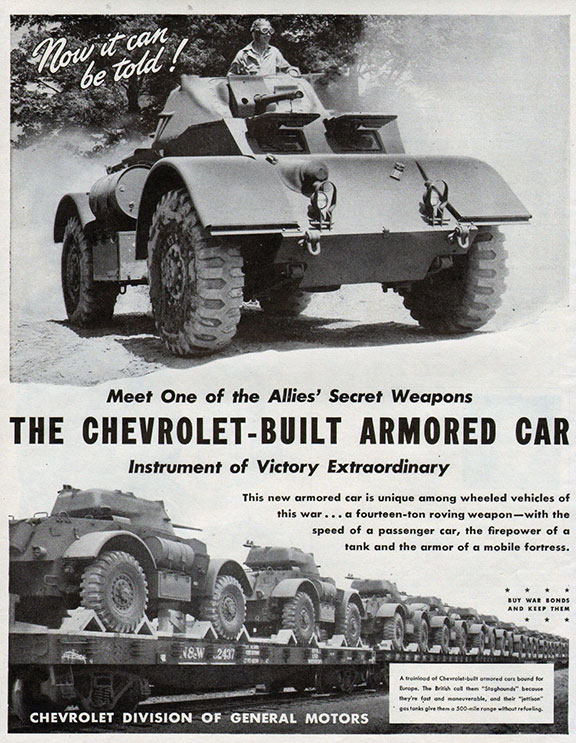
This Chevrolet ad makes it known that its
Staghound was a secret weapon. Not only was its
production a secret; but due to the fact that it was not used by US
forces during the Second World War, it has been overlooked and somewhat
of a secret ever since. Staghounds were used by British
Commonwealth nations, especially the Canadians, during World War Two,
while Polish forces in Italy were the biggest user of it.
|
Chevrolet Staghound and Boarhound World War Two Production |
| |
T17E1
Staghound |
T17E2
Staghound |
Comments |
| 1942 |
157 |
|
Production of the T17E2 started in October. |
| 1943 |
2,687 |
211 |
|
| 1944 |
|
789 |
|
| Totals |
2,844 |
1,000 |
Chevrolet produced a total of 3,844 of the T17armored cars
between October, 1942 and April, 1944 when production of all
types ceased. |
Author's Aside: The Staghound
and I go all the way back to when I was in early grade school. My
first set of plastic army men included a Staghound armored car. I played
with it until I outgrew playing with army men. However, I still
have that collection of army men with the Staghound. Now my
grandchildren play with it. The day the photo below was taken my
oldest grandson was playing with the set of army men.
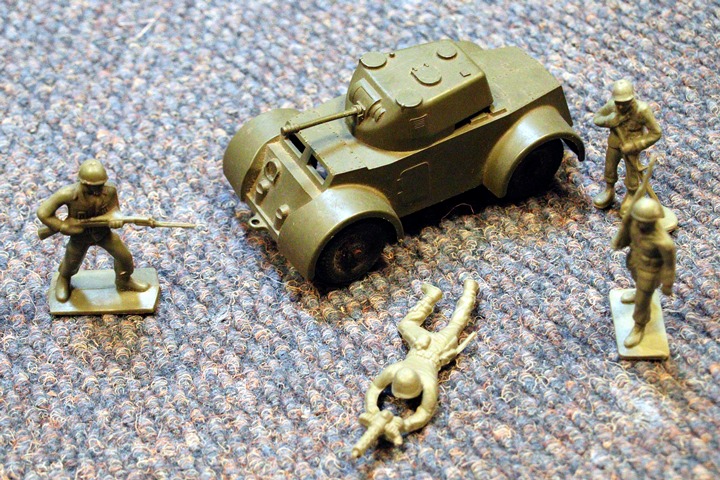
Author's photo added 1-11-2023.
Staghound T17E1 Walk Around and Interior
Views:
The Staghound featured below is part of the superb collection of
World War Two vehicles at the Wheels of Liberation in Gettysburg, PA.
From all appearances, the interior seems to be original. The
Wheels of Liberation was still in the process of consolidating its
collection into one location when I visited in September 2022.
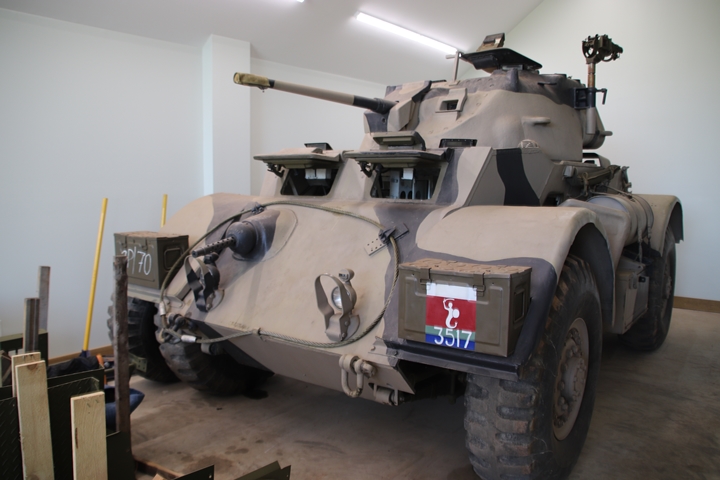
The machine gun mount on the turret is an
addition to the original vehicle. Author's photo added 1-11-2023.
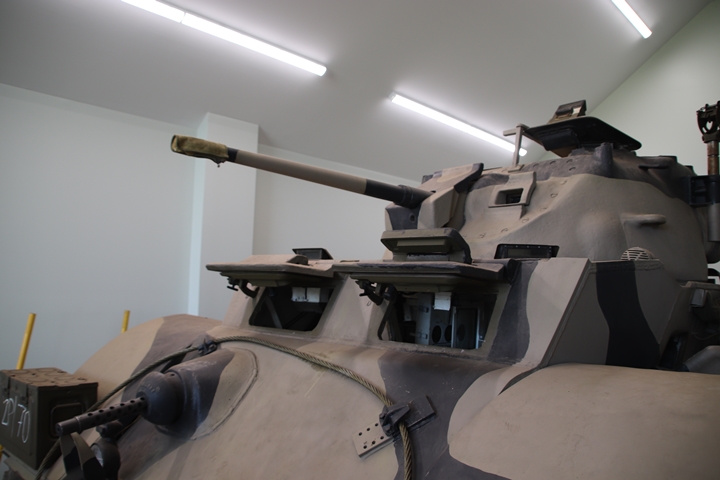
Author's photo added 1-11-2023.
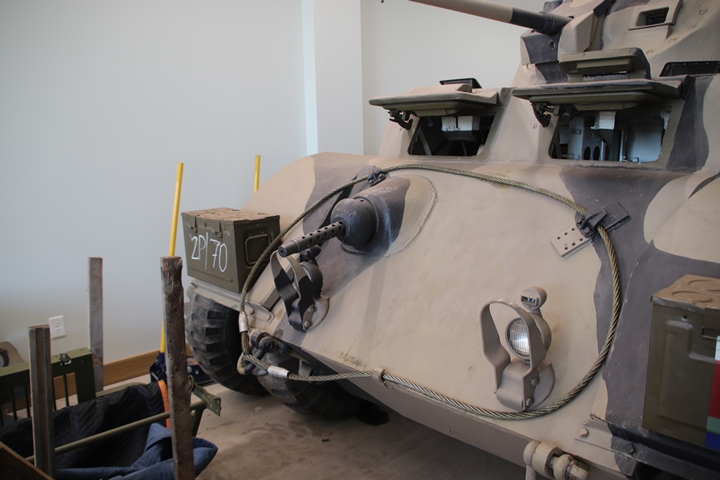
Author's photo added 1-11-2023.
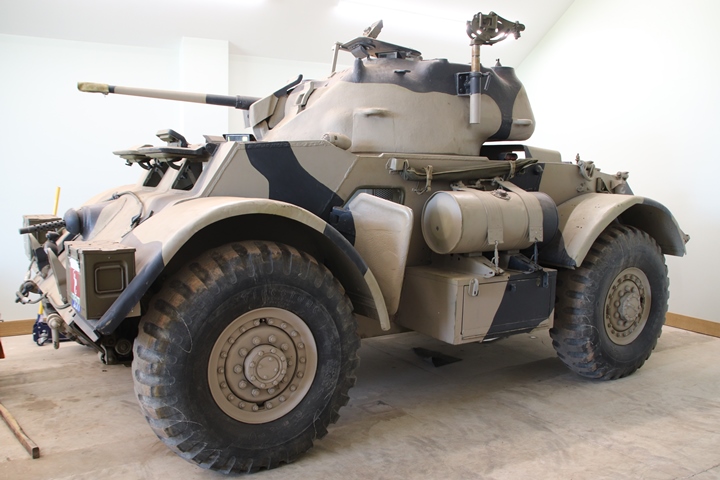
The side door was open. This allowed
me to take some photos of the interior. It is very rarely that one
is able to view the inside of armored vehicles. Author's photo added
1-11-2023.
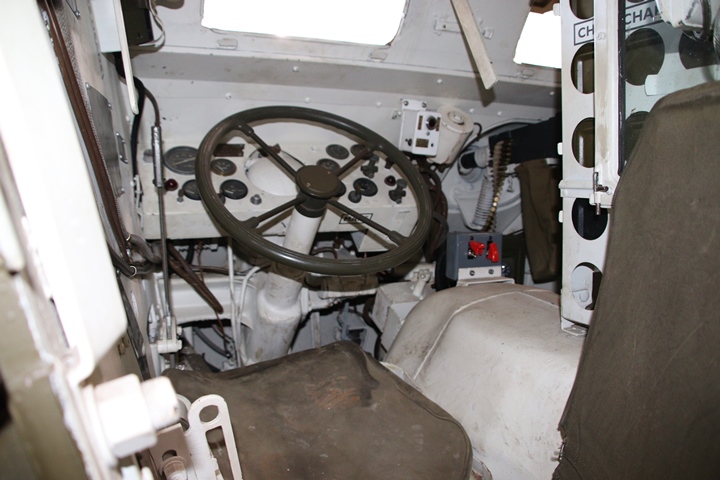
Author's photo added 1-11-2023.
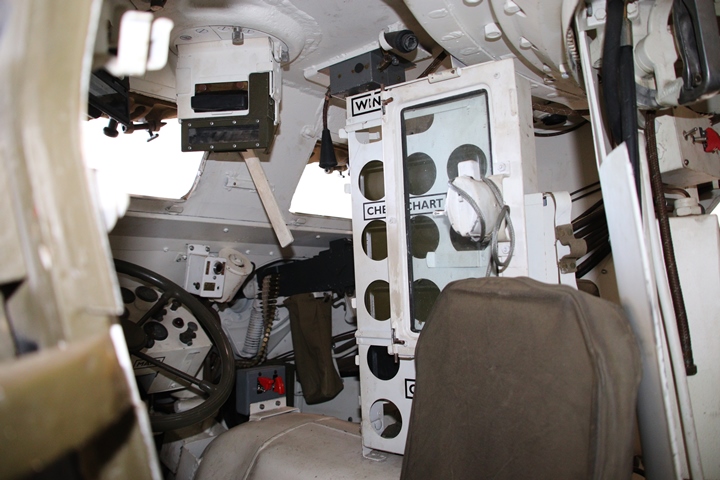
The 7.62mm machine gun operated by the
assistant drive can be seen in the background. This indicates this
vehicle was in service after World War Two when the 7.62mm cartridge
became the standard for NATO countries. A photo further down in
the turret shows an ammunition box with 7.62mm marked on it.
Author's photo added 1-11-2023.
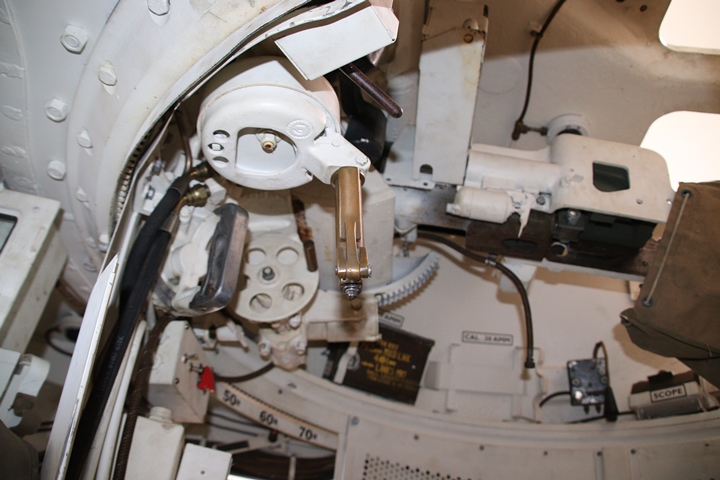
This and the next several images show the
inside of the turret. The breech for the 37mm cannon can be seen
in the upper left of the photo. Author's photo added 1-11-2023.
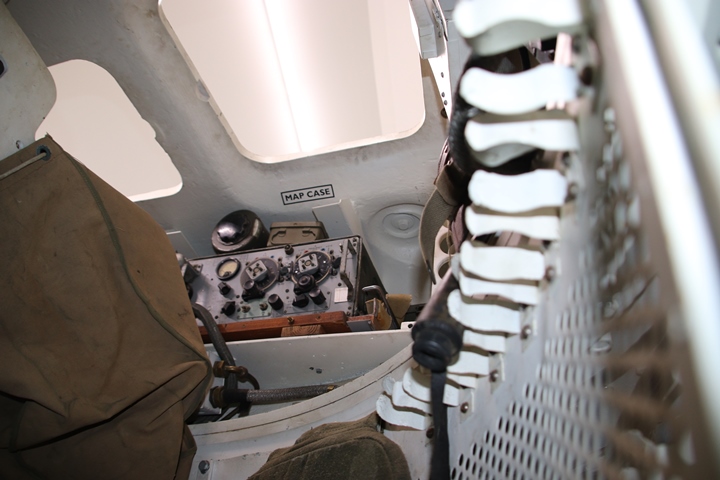
The radio is the type used by the British
and other Commonwealth countries. Author's photo added 1-11-2023.
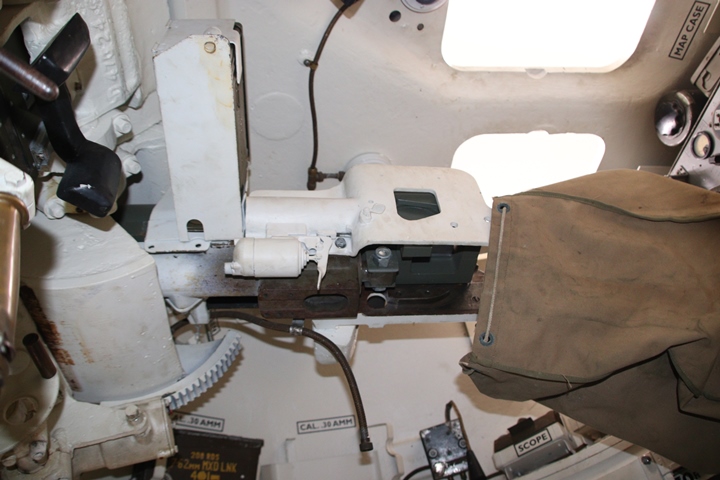
Author's photo added 1-11-2023.
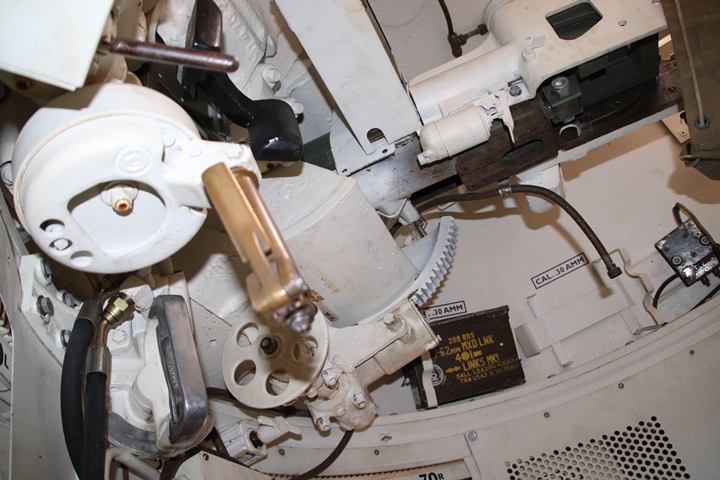
On the turret wall is the previously
mentioned ammunition can which is marked 7.62mm. Author's photo
added 1-11-2023.
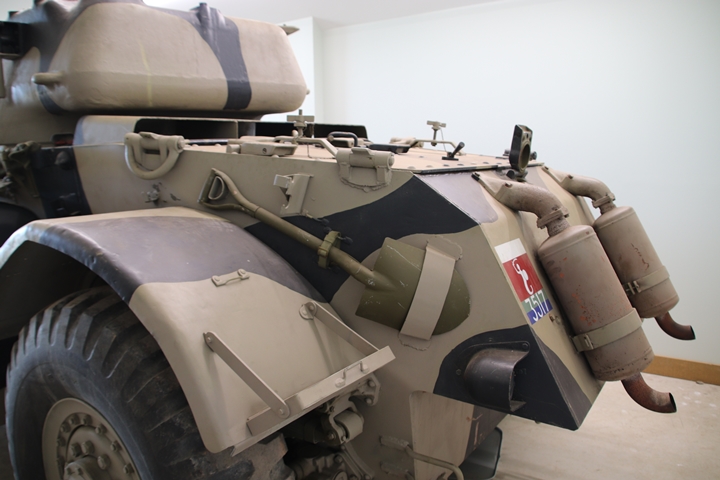
Author's photo added 1-11-2023.
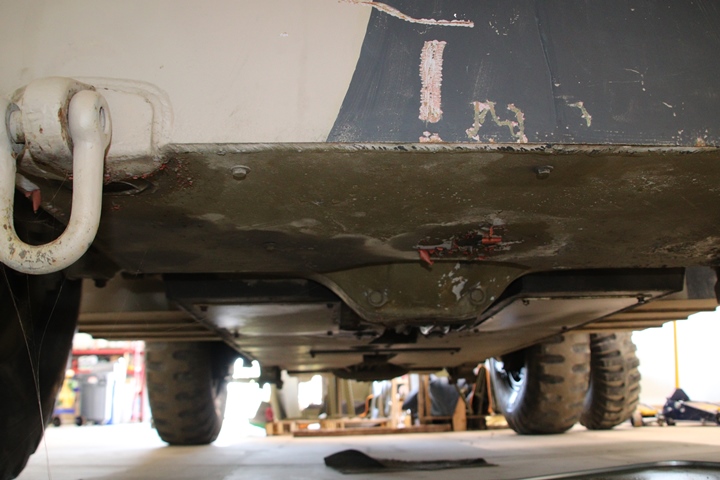
Author's photo added 1-11-2023.
Other Surviving T17E1
Staghounds:
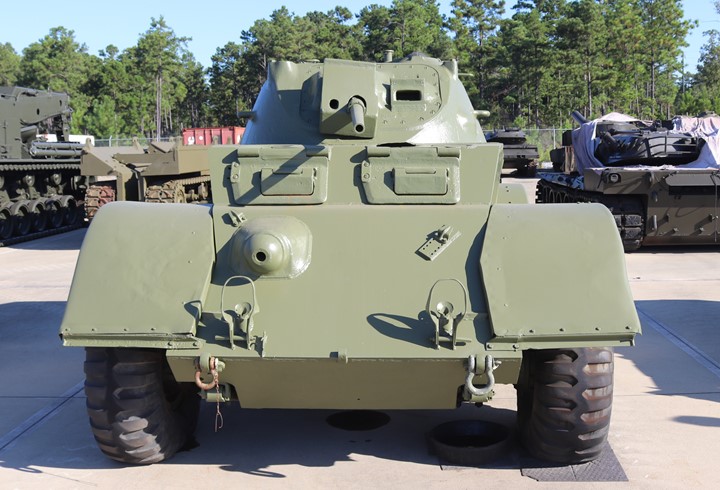
This Chevrolet-built Staghound armored car
has a fresh coat of paint. It is temporarily stored outdoors while
awaiting placement into a new inside display area as part of the U.S.
Army Armor and Cavalry Collection, Fort Benning, GA. Author's photo added 9-21-2018.
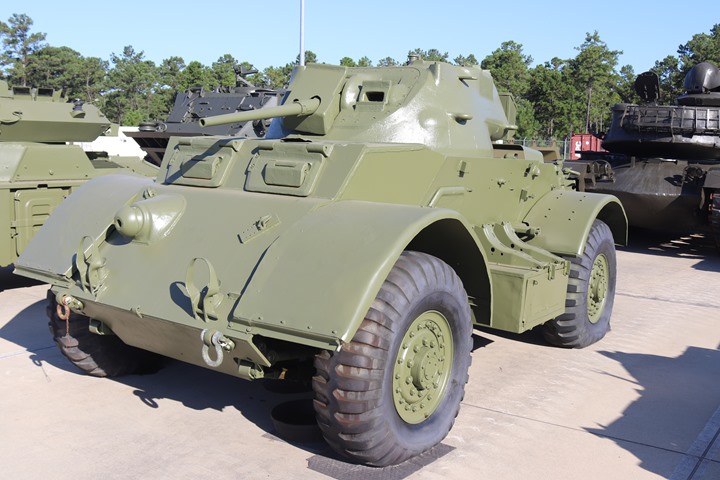
Author's photo added 9-21-2018.
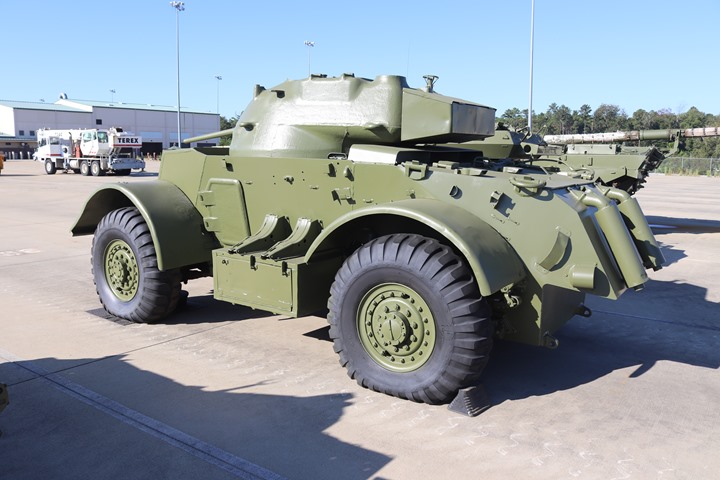
Author's photo added 9-21-2018.
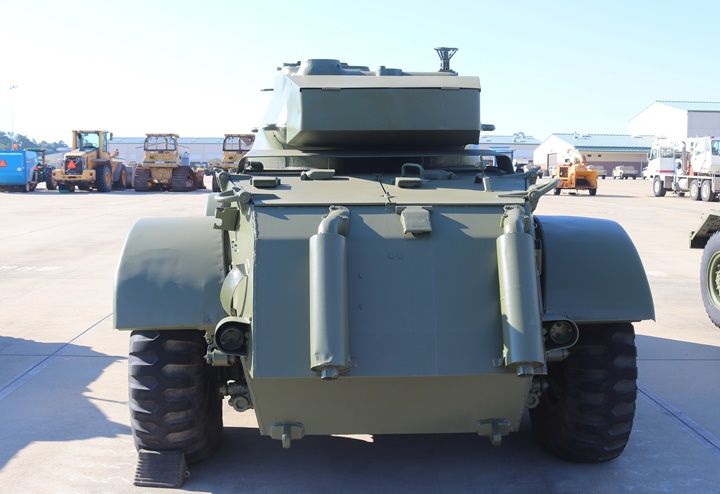
Author's photo added 9-21-2018.
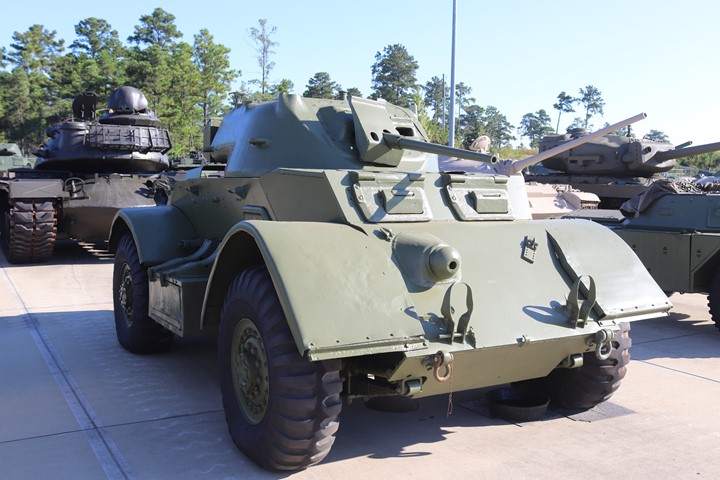
Author's photo added 9-21-2018.
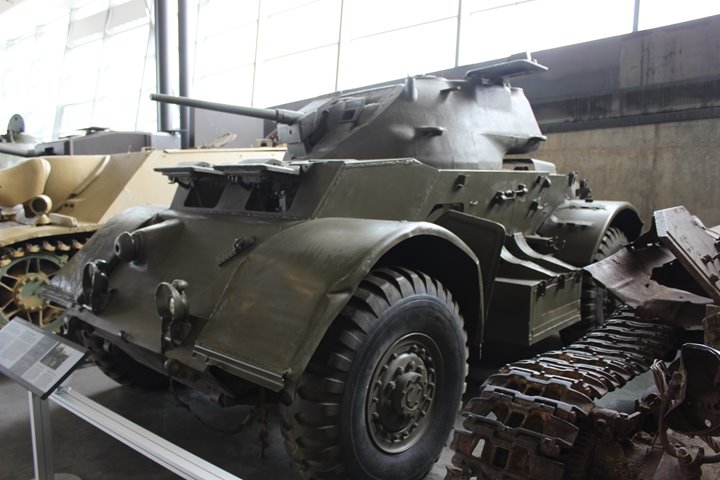
This Chevrolet-built T17E1 Staghound is on
display at the Canadian War Museum in Ottawa, ONT. Author's photo
added 9-13-2016.
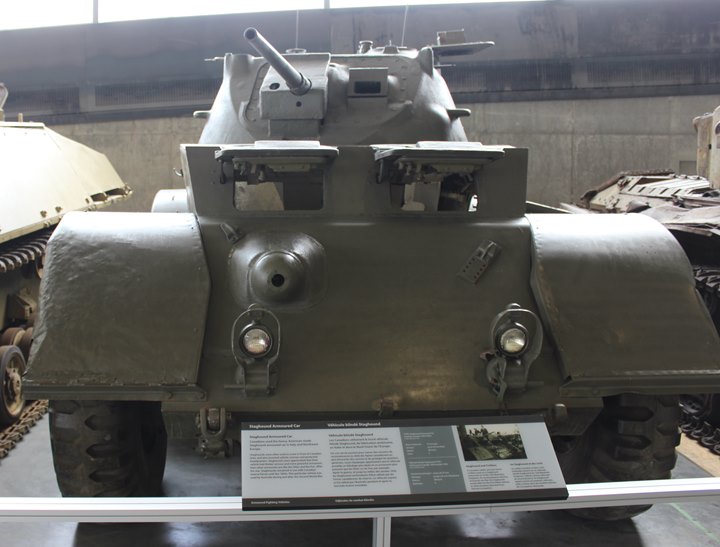
Author's photo added 9-13-2016.
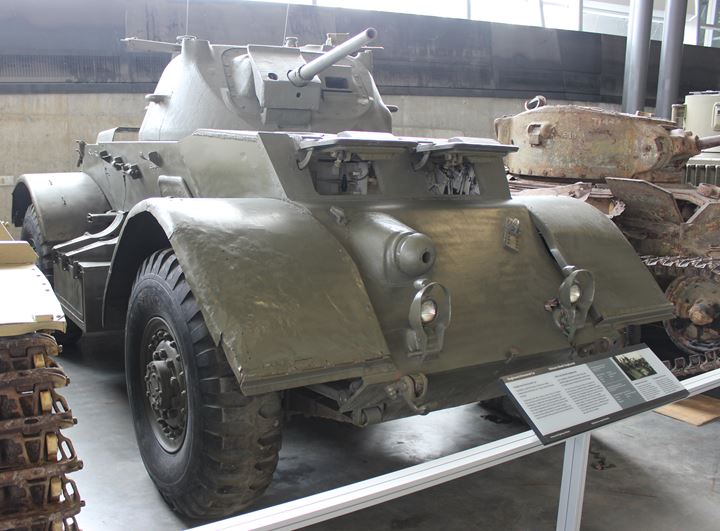
Author's photo added 9-13-2016.
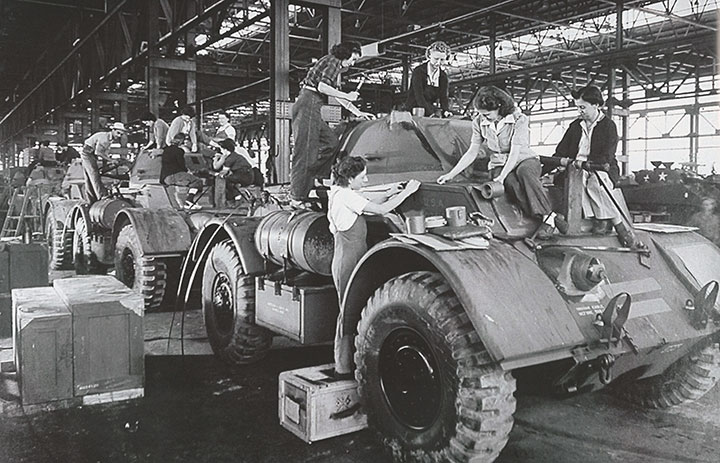
What a cool photo! Nine of the ten
persons in this photo preparing the first two Staghounds for shipment
overseas are women. Photo courtesy of the Military
History Institute in Carlisle, PA.
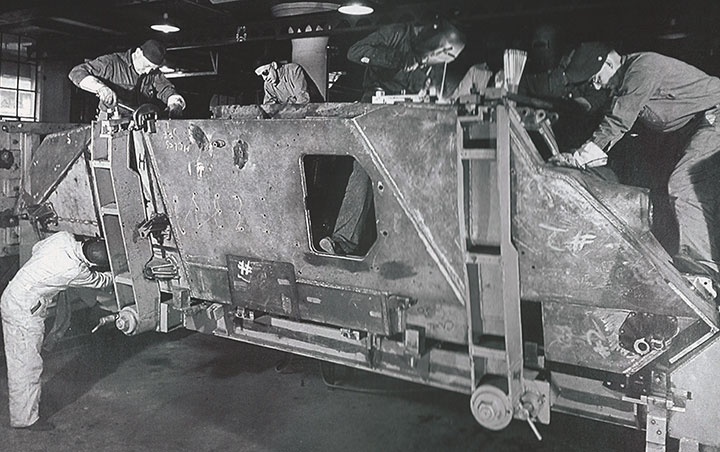
Here a Staghound hull is being welded.
Other Armored Cars:
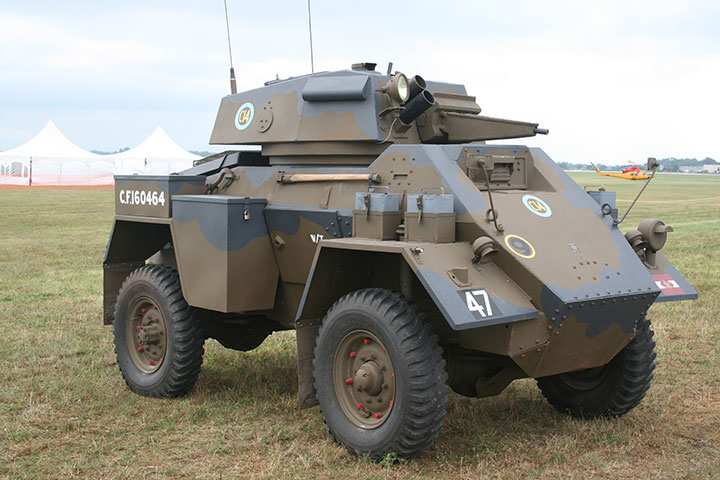
This Fox Armored Car seen at 2009 Windsor,
Ontario Airshow was designated as a GM MK.1, but Chevrolet was the
Division that designed the chassis. Final assembly was done by GM
of Canada. Author's photo.
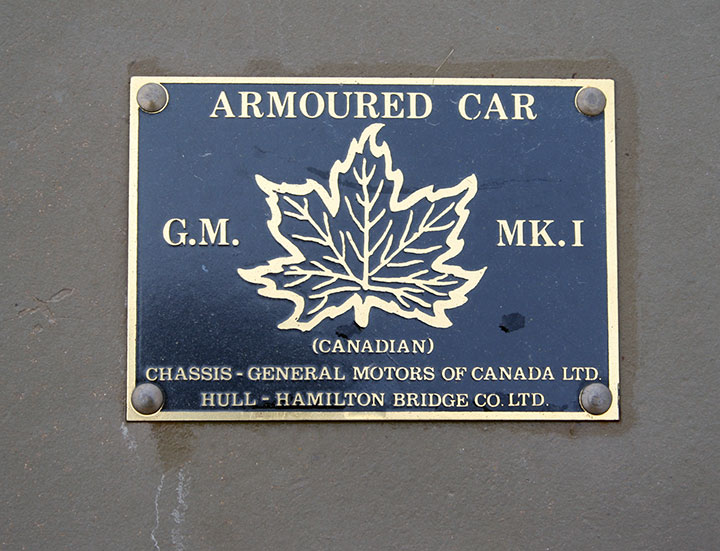
Author's photo.
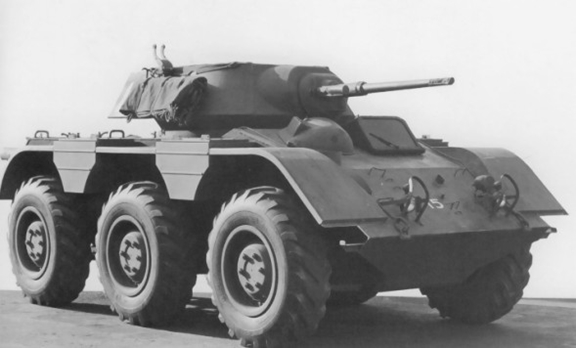
Chevrolet began development on the M38
armored car in 1944 as a replacement for the M8 Greyhound.
Production on the new armored car did not get started until March 1945.
Only five pilot models were built due to the ending of the war in
Europe. The M38 was powered by a Cadillac V-8 engine mated to a
Detroit Transmission Hydra-Matic transmission. Photo added
1-8-2020.
90mm Anti-Aircraft Gun Components:
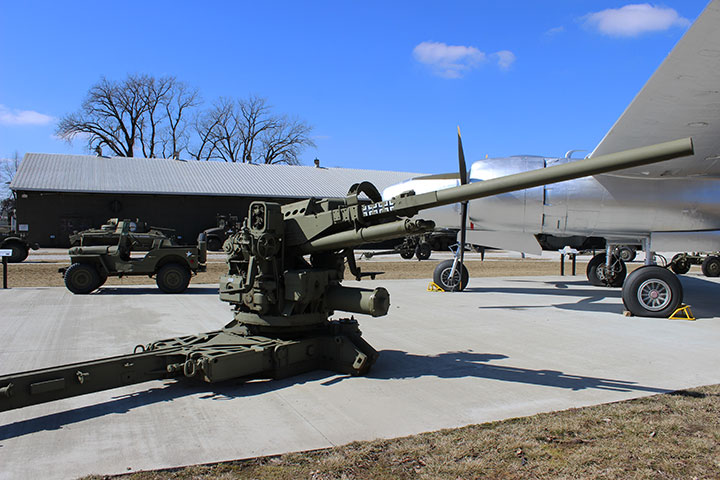
Chevrolet built 2,000 gun tubes, breech ring
and block assemblies, and recoil rails for 90mm anti-aircraft guns like this one
seen at the Indiana Military Museum in Vincennes, IN. Author's photo.
On the Job - Chevrolet
Volume Production for the Nation's Needs
This publication gives an excellent overview
of what Chevrolet did by those who worked there
during the Second World War. This was dated September 11, 1944.
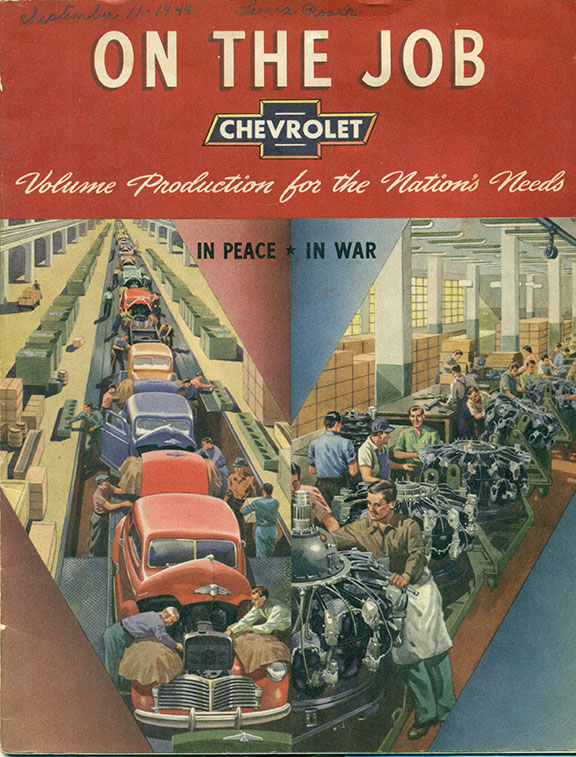
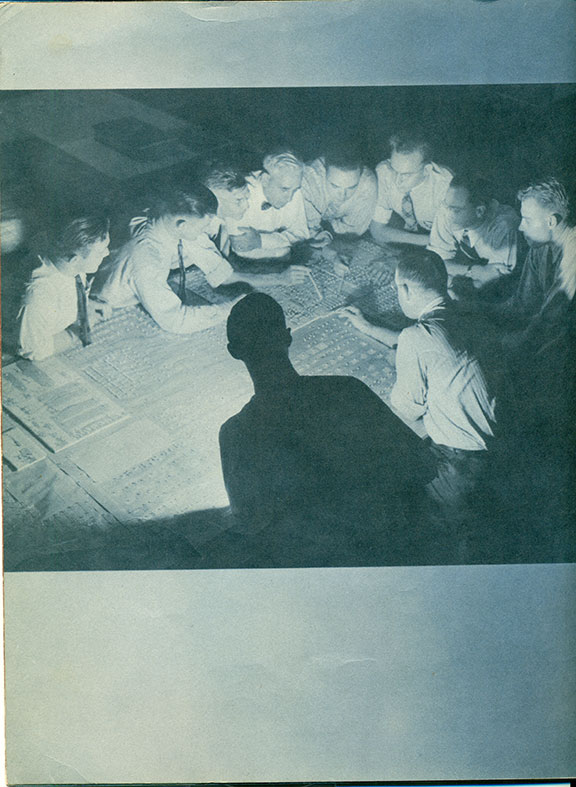
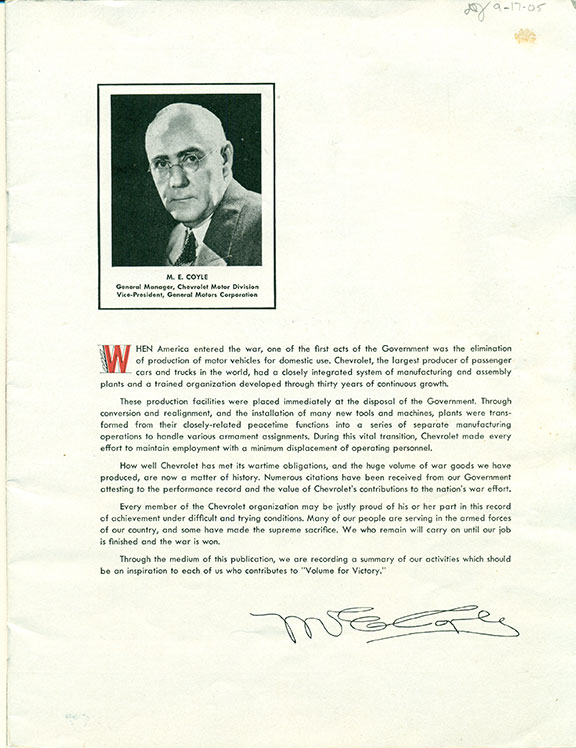
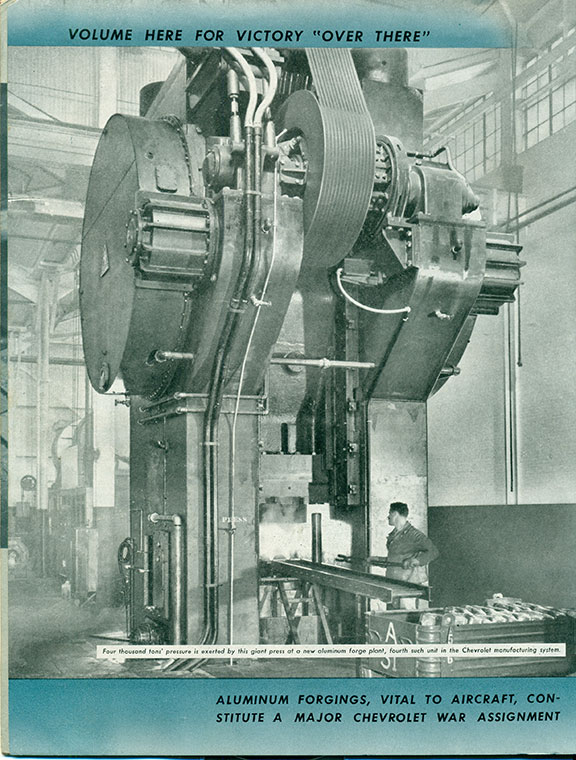
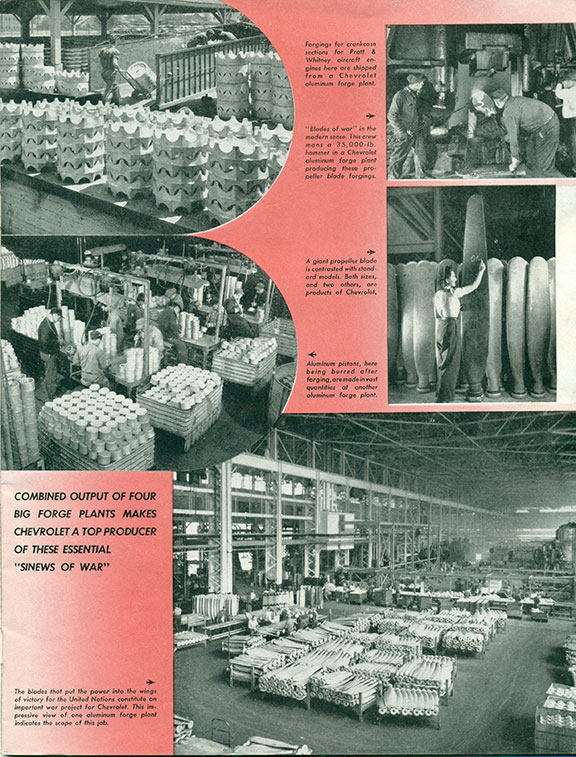
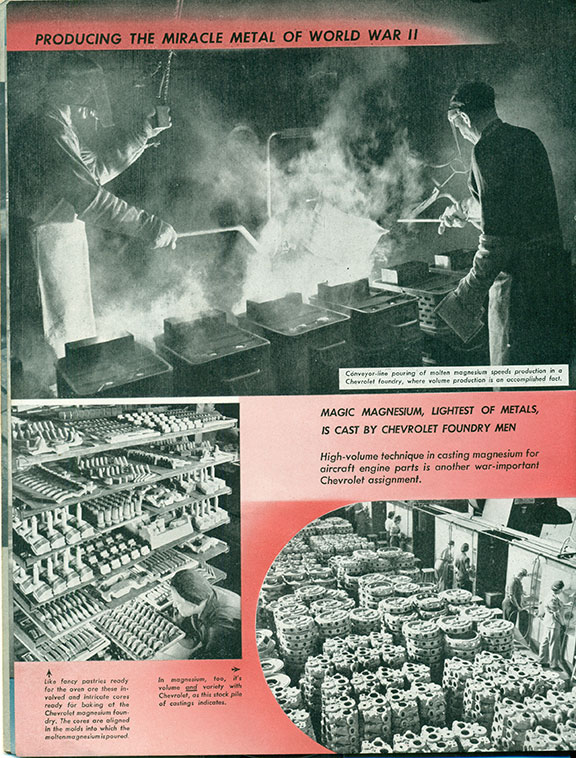

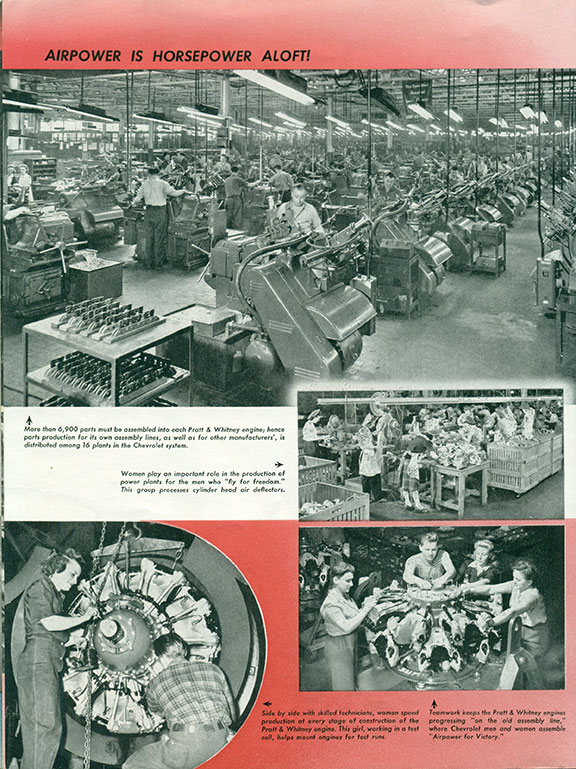
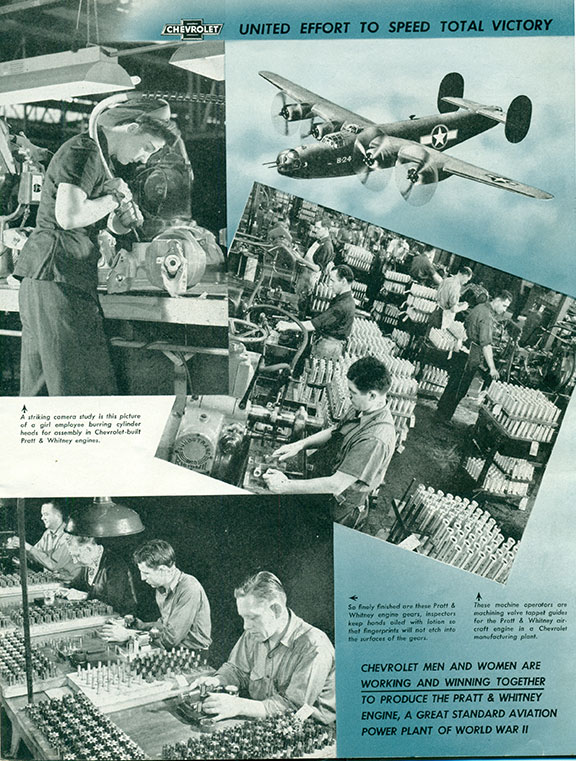
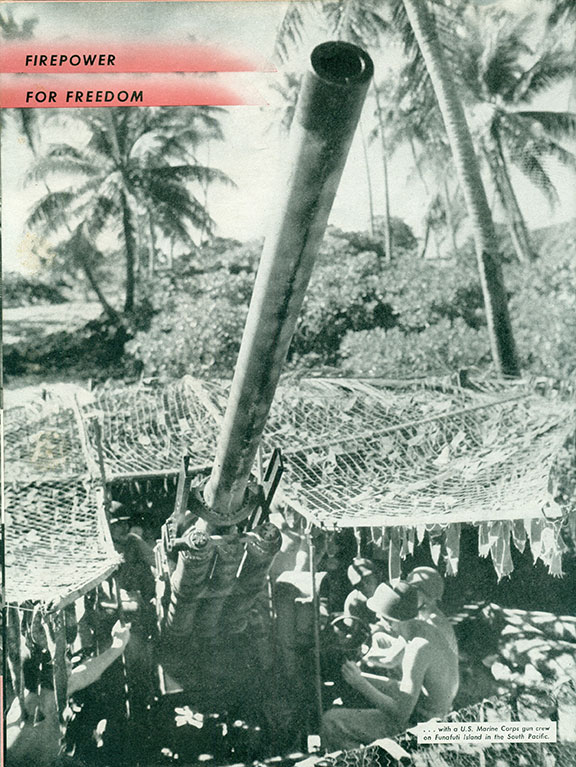
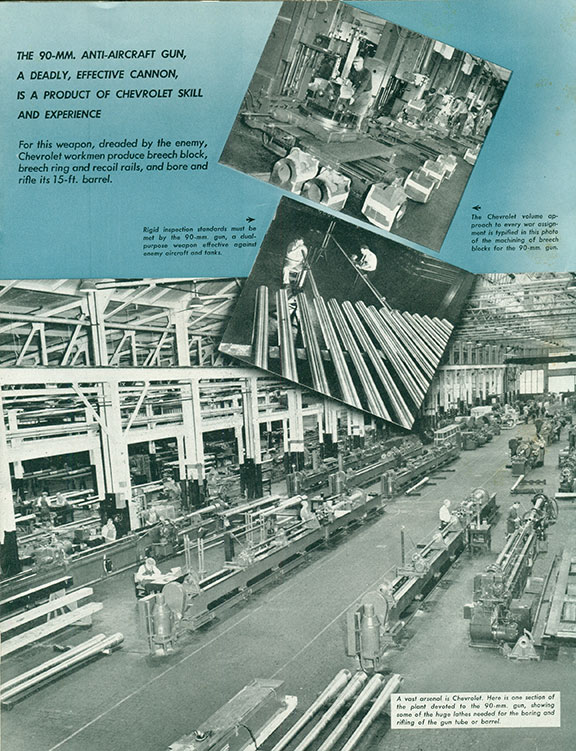
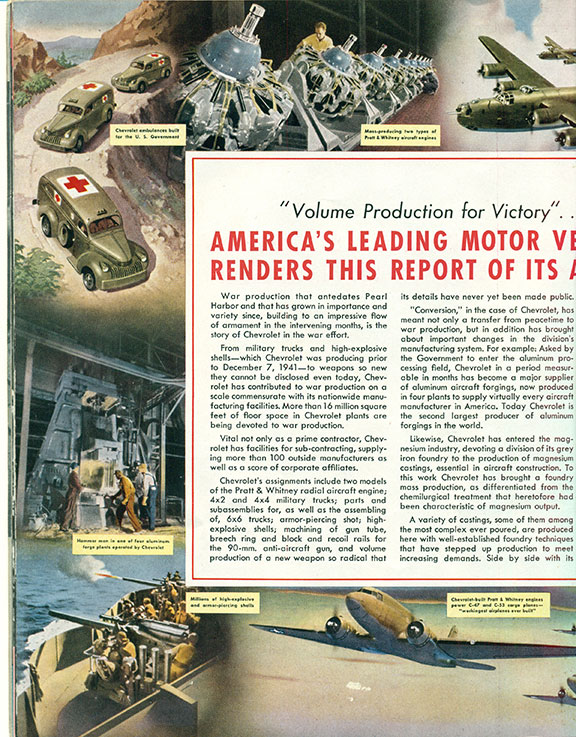
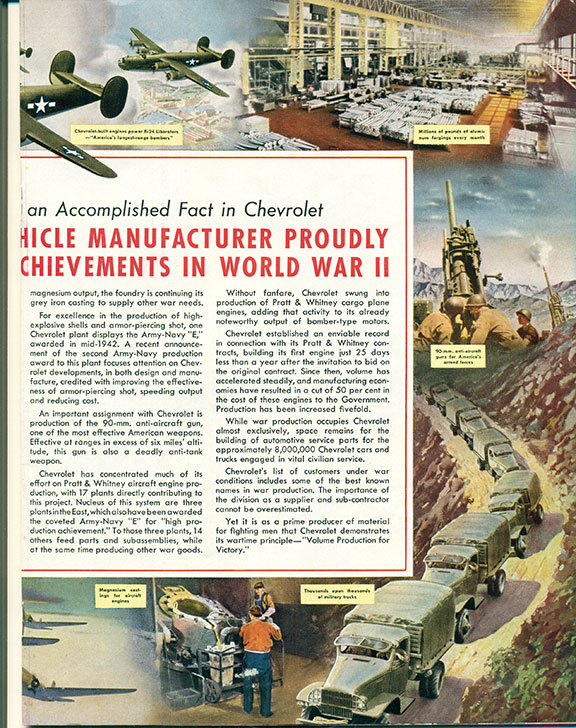
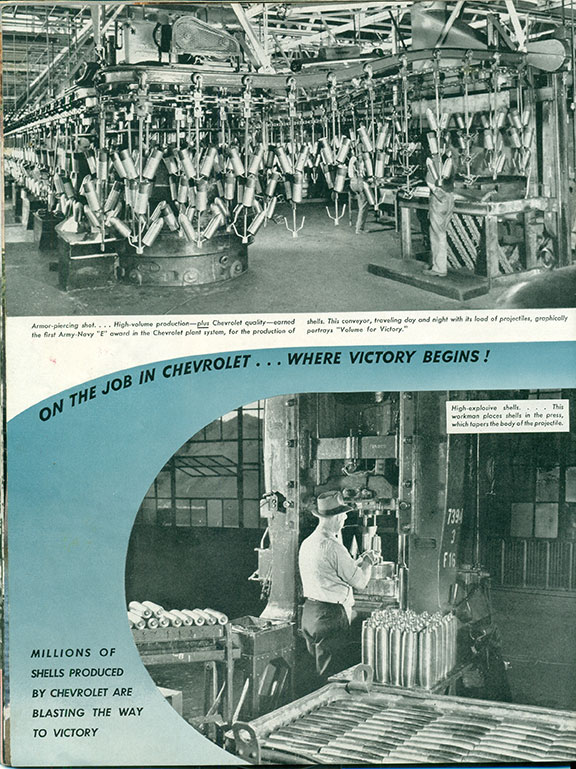
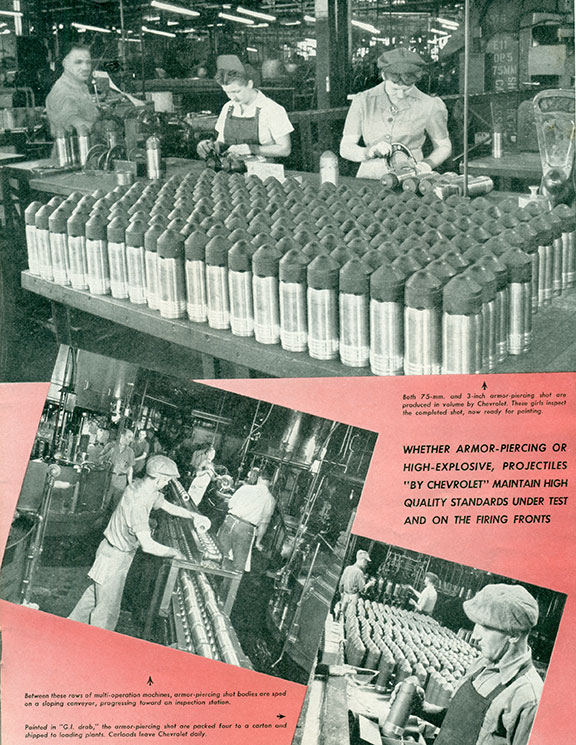
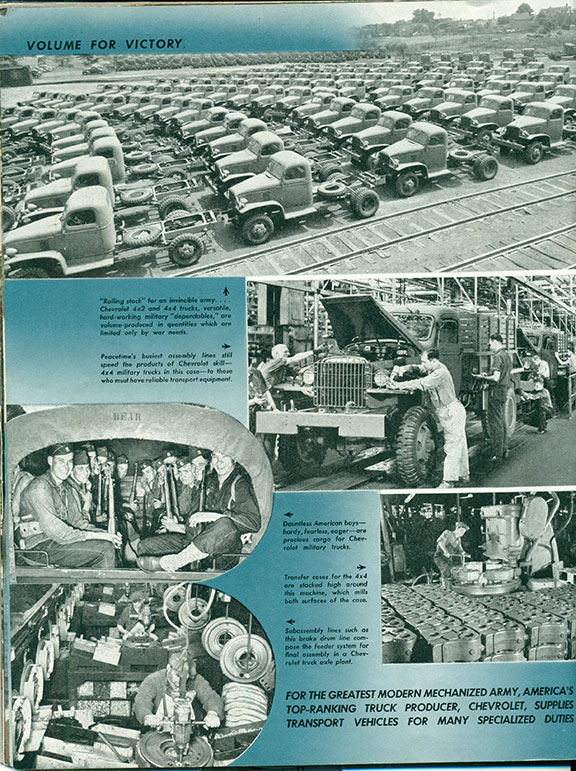
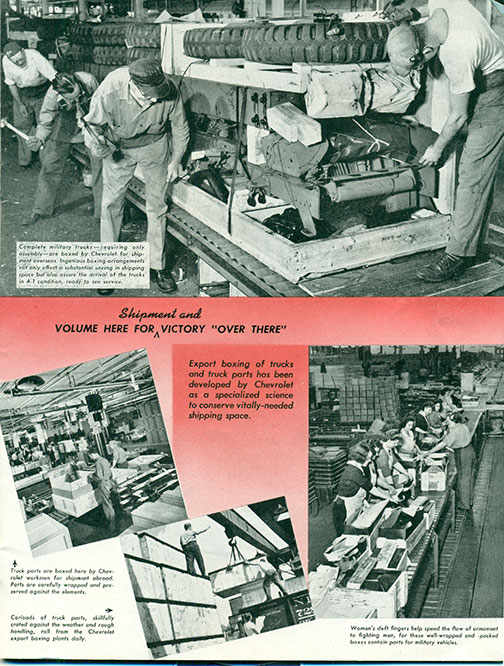
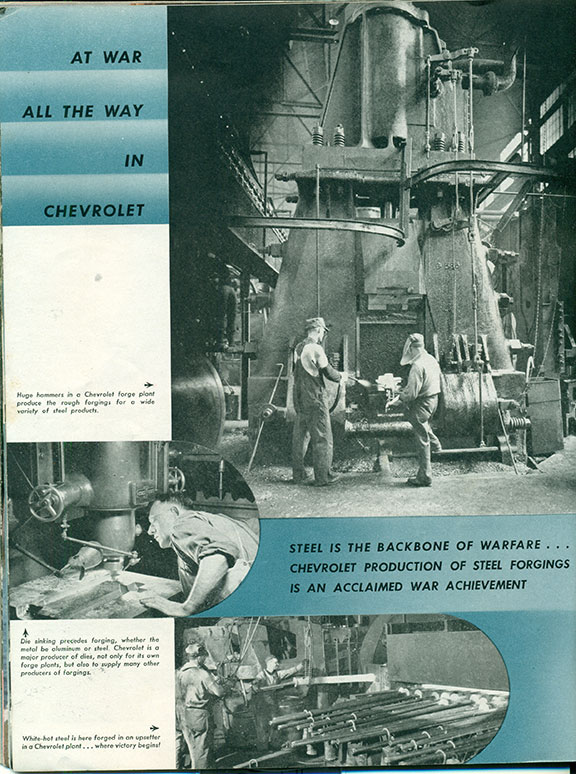
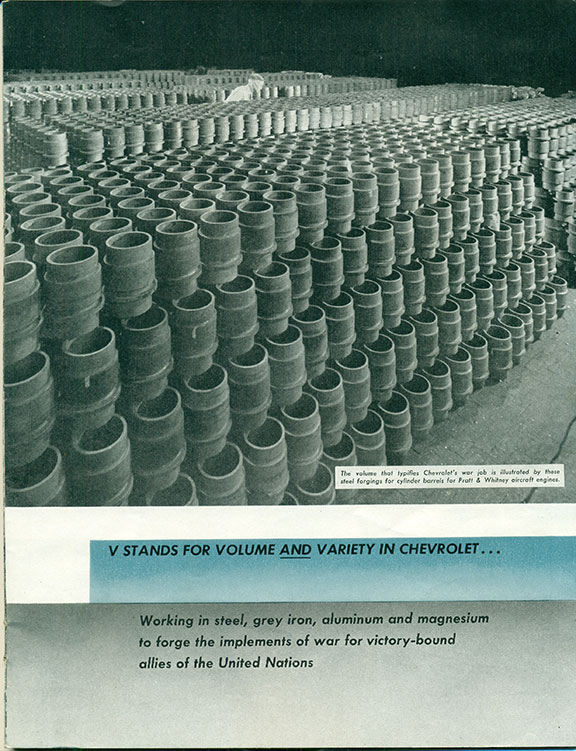
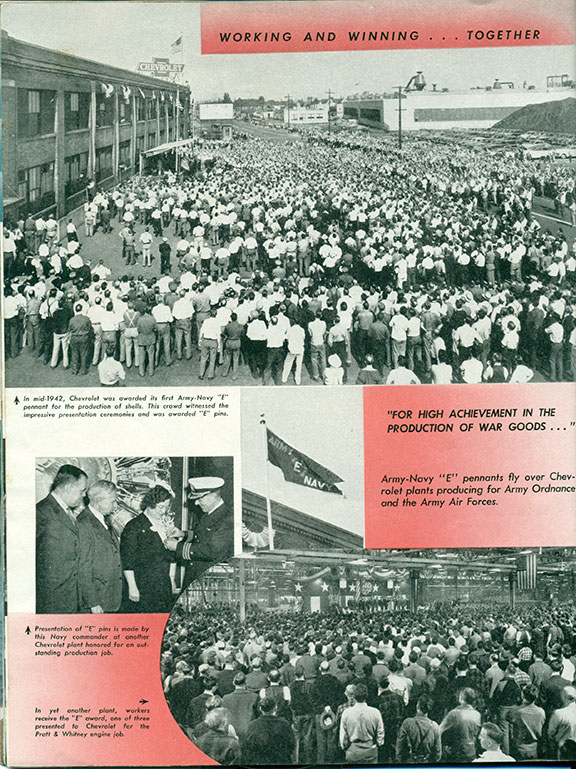
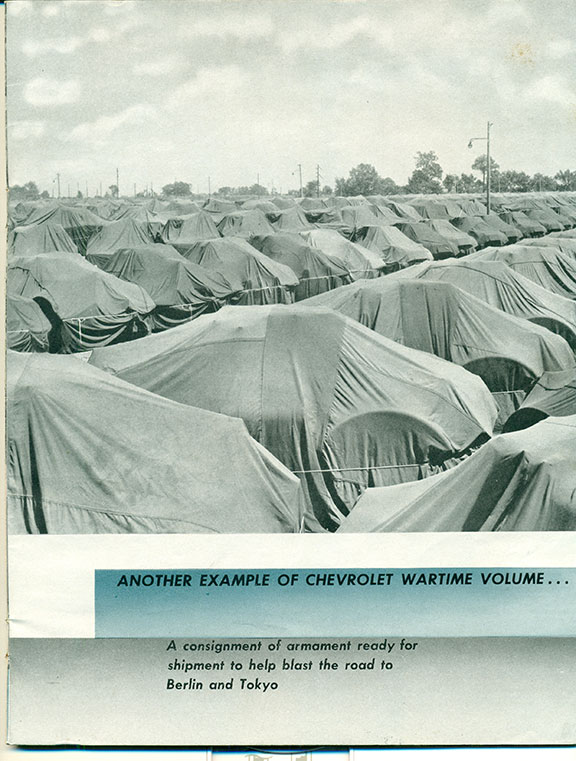
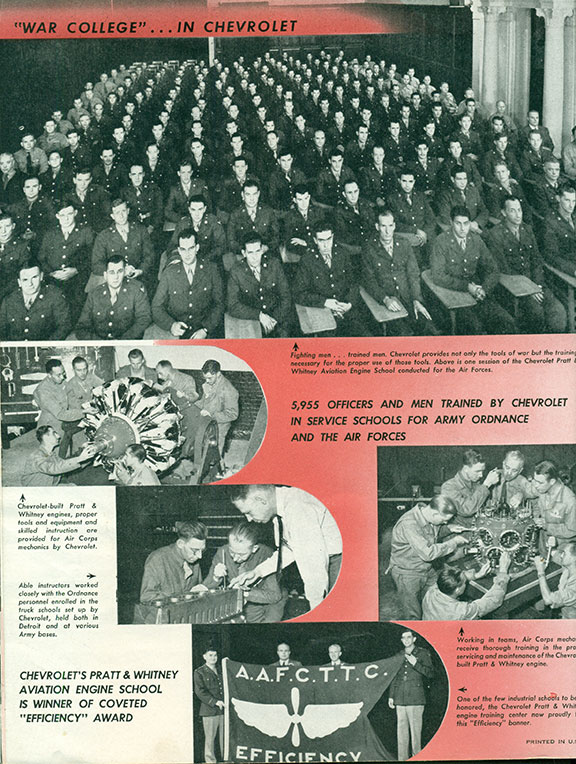
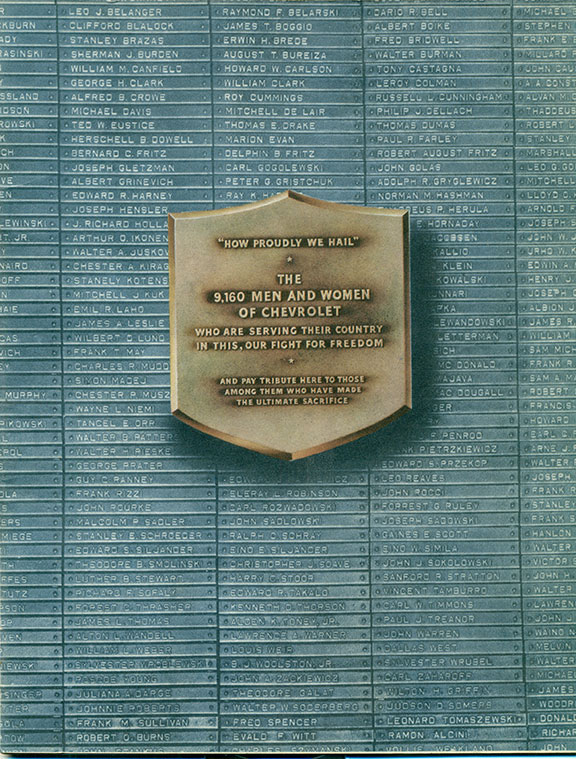
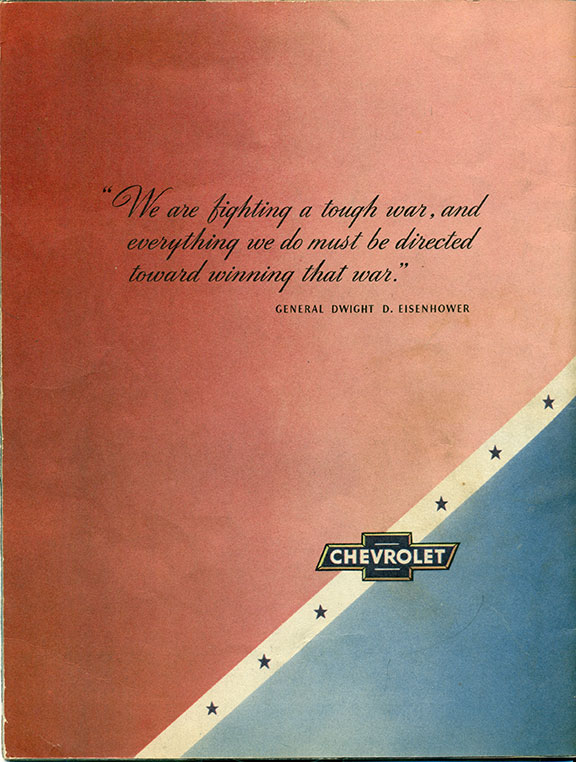
|



































































































































